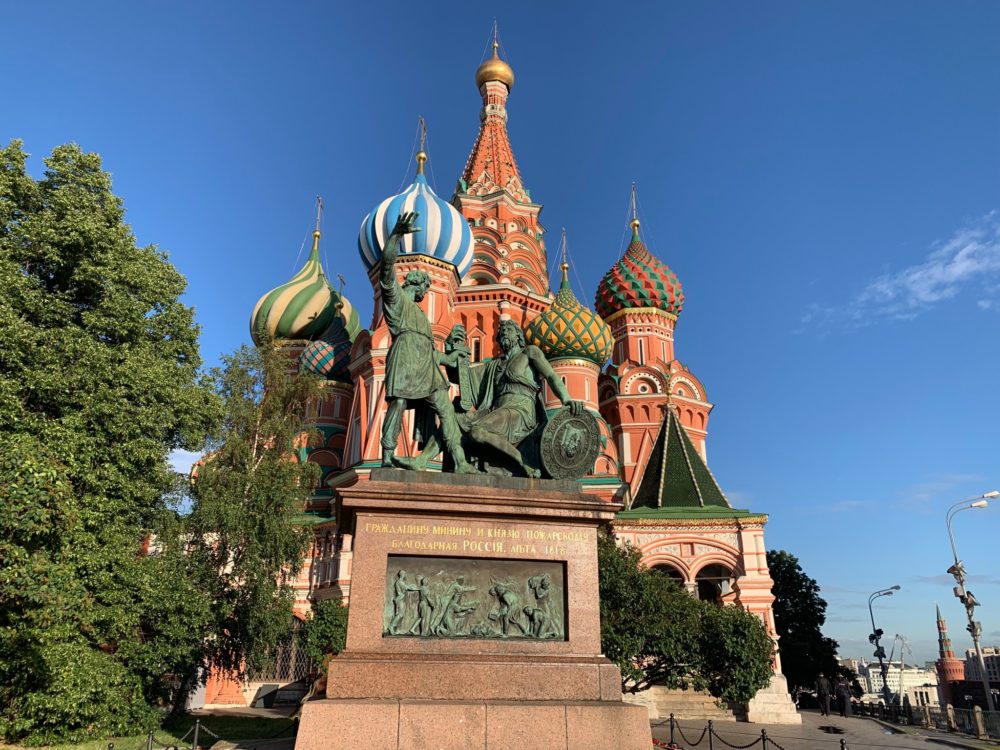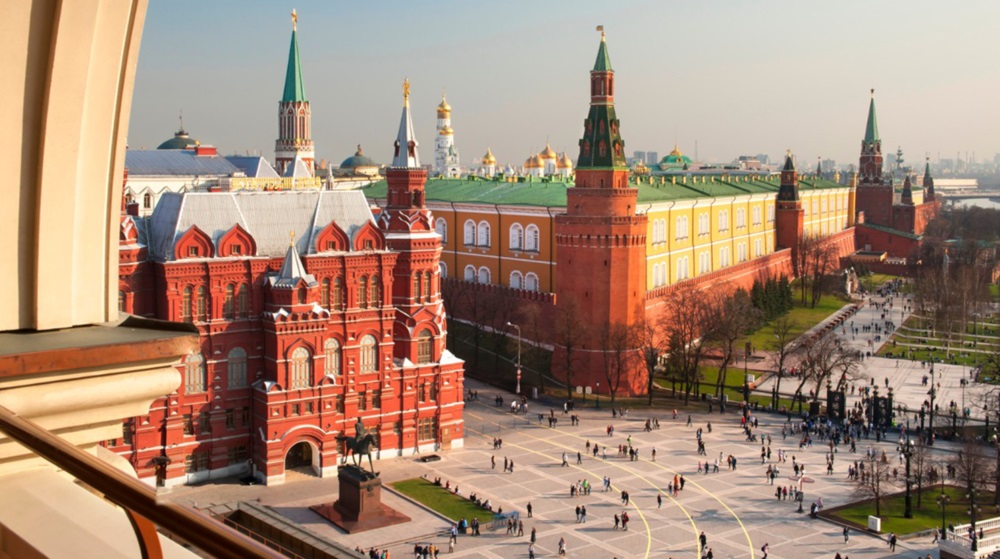
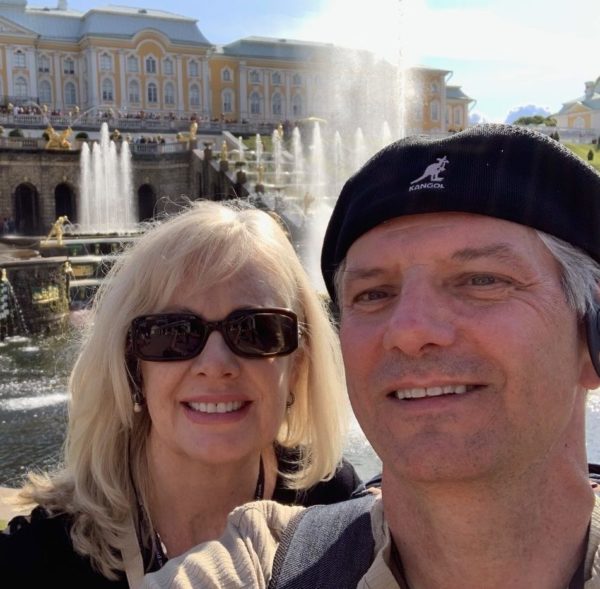
Larry & Audrey Ketchersid
2019 Volga Dream Platinum
Story# 2. Red Square, the Kremlin and surrounding sites – Moscow, Russia
On our recent trip to Moscow we stayed within walking distance of Red Square. We visited multiple times during our five days in Moscow, including a visit to Lenin’s Mausoleum (separate article here), a tour of the inside of the Kremlin including the Armory, a walk through St. Basil’s Cathedral, a visit to the 1812 War museum and quite a bit more. The Kremlin and Red Square became UNESCO World Heritage sites in 1990. Part of these visits were done with Natalya, our wonderful guide with the Volga Dream river cruise (more on the cruise, which went from Moscow to Saint Petersburg, in another post). Part was done on our own, as we got to Moscow two days before the tour as there was so much to see – hence the long post (the first of several).
Since this is a bit long with lots of photos and videos, readers who would like to can jump to different sections here:
•Cathedral of Christ the Savior
•Museum of the Great Patriotic War of 1812
Red Square (Красная площадь)
Red Square is bordered by the Kremlin and the GUM department store on opposite sides, and the Russia Historical Museum and St. Basil’s Cathedral on opposite ends. The area started to be called Red Square in the late 1690s, during the time of Peter the Great. He staged “a spectacle to celebrate his recent capture of the Black Sea port of Azoz from the Turks”1 there.
During the rebuilding of Moscow after the fire in the War of 1812, “Red Square acquired its current shape. and the Kremlin ceased to be an island surrounded by moats.”2Below is a map that shows where Red Square sits in relation to the Kremlin and other landmarks.
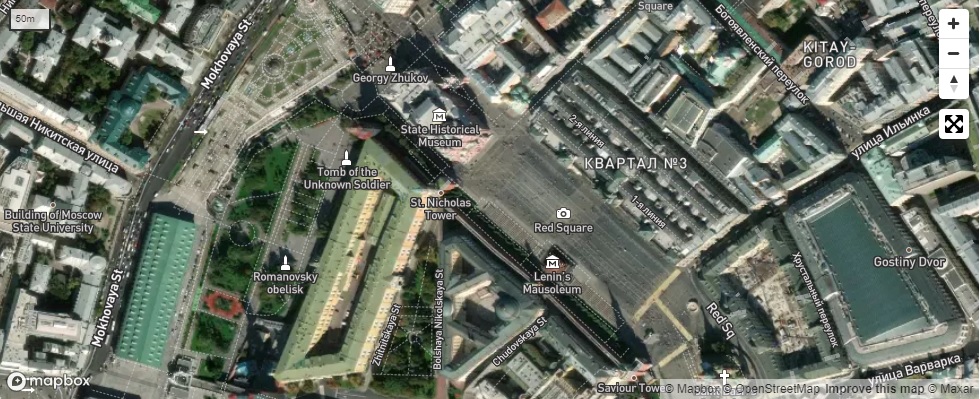
St. Basil’s Cathedral (The Cathedral of the Protecting Veil of the Most Holy Mother of God on the Moat)
The cathedral is made up of ten churches. (1) The highest tower in the middle with the gold onion dome on top is the Church of the Protecting Veil of the Most Holy Mother of God; this church was erected in 1555 – 1561. (2) The blue and white onion dome sits atop the Church of Saint Cyprian and Justina. (3) The dome of gold with green lines around it is the Church of Saint Gregory of Armenia. (4) The red and green dome sits atop the Church of the Lord’s Entry into Jerusalem. (7) The dome with green and white swirls to the left in the photo above is the Church of the Holy Trinity. (9) The very small red and green onion dome at the left, just below the green and white dome, is the top of the Church of the Three Patriarchs of Constantinople.
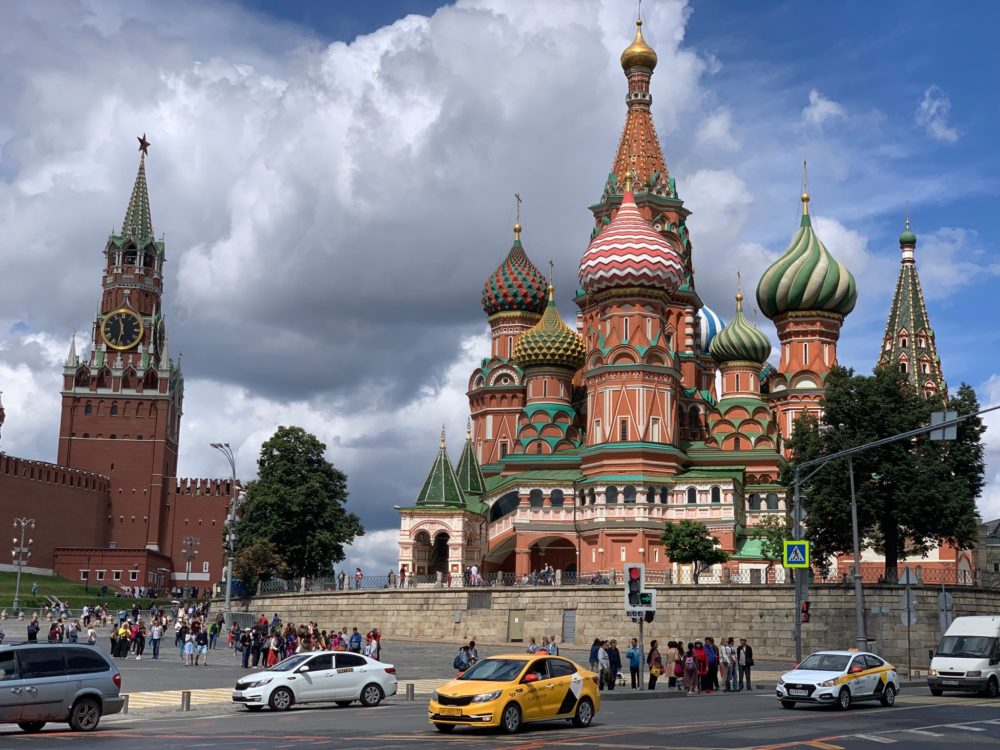
In the picture above take from behind the cathedral, the other churches can be seen. (6) The red and white domed church in the middle is the Church of the Velikoretsky image of Saint Nicholas the Wonderworker. (5) The dome to the left of it with green and yellow is the Church of Saint Barlaam of Khutyn. (8) The dome with the swirled green, black and white is the Church of Saint Alexander of Svir.
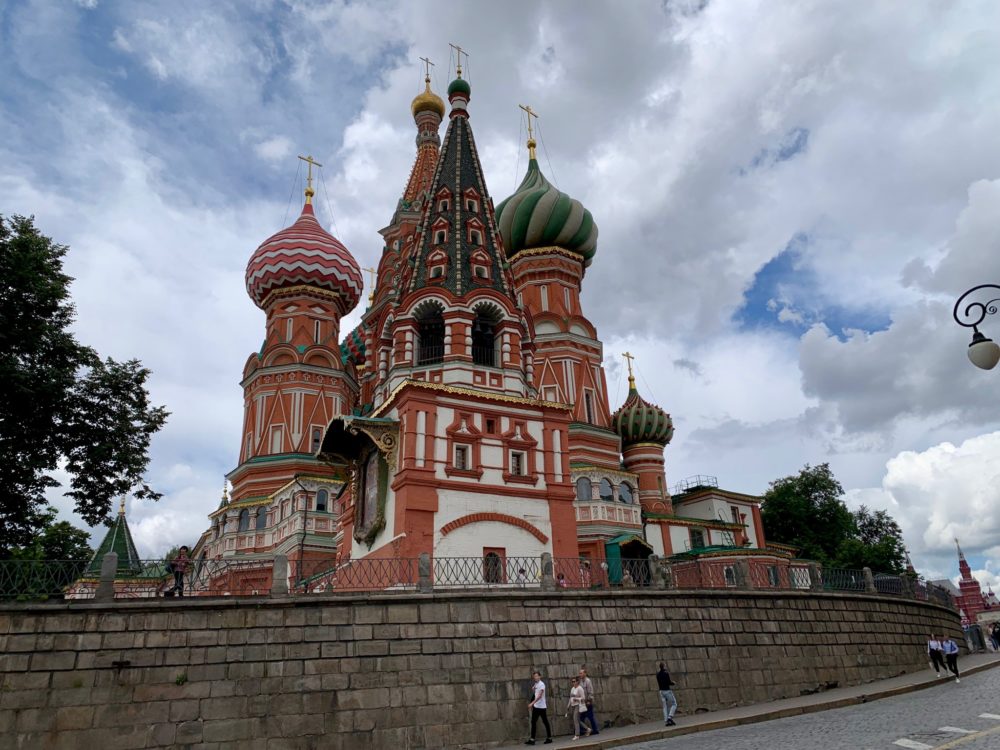
And finally, above is a view from the side opposite the Kremlin. (10) The dome to the far right with green swirl and red points is the cathedral commonly known as St. Basil’s Cathedral. It is formally the Cathedral of Vassily the Blessed (собо́р Васи́лия Блаже́нного).
All of these churches are connected on the inside, making it easy to get lost if you lose sight of your guide. The rooms in each cathedral were hit and miss – some were amazingly decorated, and some were bare.
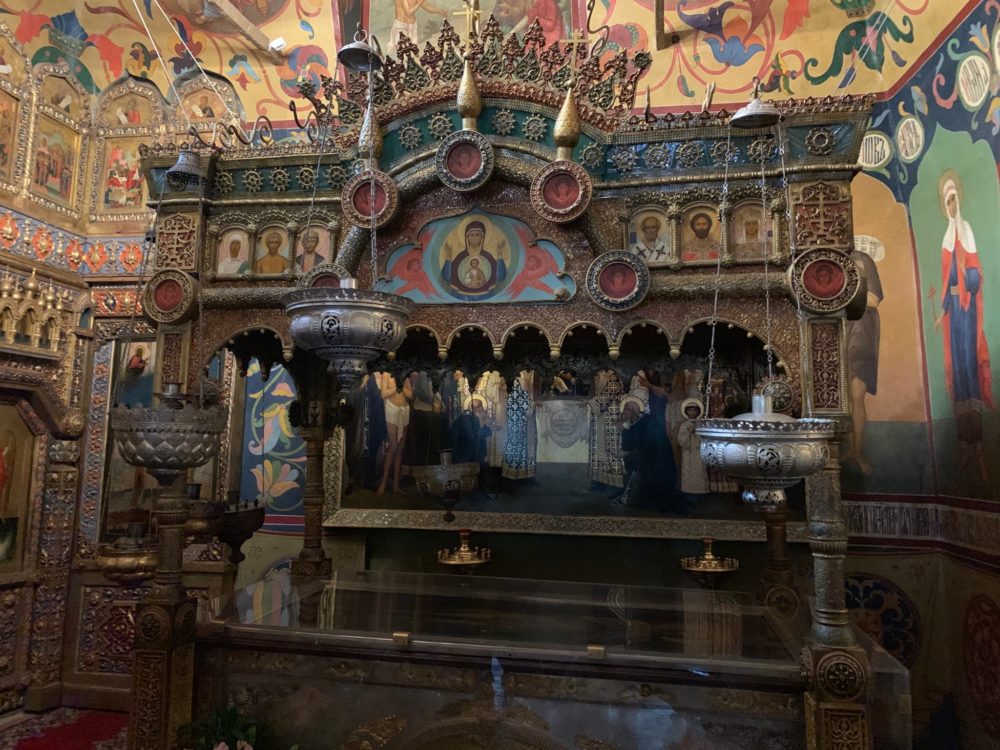
One room has a collection of artifacts and paintings of St. Vasily the Blessed Wonderworker of Moscow. A plaque in the room (which is an English translation) gives the following background:
«The fragmentary information about the life of St. Vasily the Blessed that has come down to us is largely fanciful. He was born in Moscow either in 1462 or in 1468. Having early become aware of his gift as a visionary, he began to lead the life of a vagrant. In any weather he roamed through the streets of Moscow unclothed and barefoot. Not only ordinary people but even Czar Ivan the Terrible himself whom the fool for Christ reproached for <<cruelty and every oppression>> heeded Vasily’s opinion.
Vasily lived to a great age and died in 1557. According to his last will he was laid to rest at the walls fo the Cathedral of the Protecting Veil of the Mother of God. After the canonization of St. Vasily in 1588, Czar Feodor Ioannovich caused a church to be built on to the cathedral over his tomb, and a reliquary for the saint’s relics was installed in it. So great was the veneration in which the Moscow wonder worker was held by the people that the Cathedral of the Protecting Veil received another, better known name – the Cathedral of St. Vasily the Blessed (or St. Basil’s Cathedral as it is often called in English).»
Below is a photo of the Pall for the Shrine of St. Basil the Blessed, from 1589.
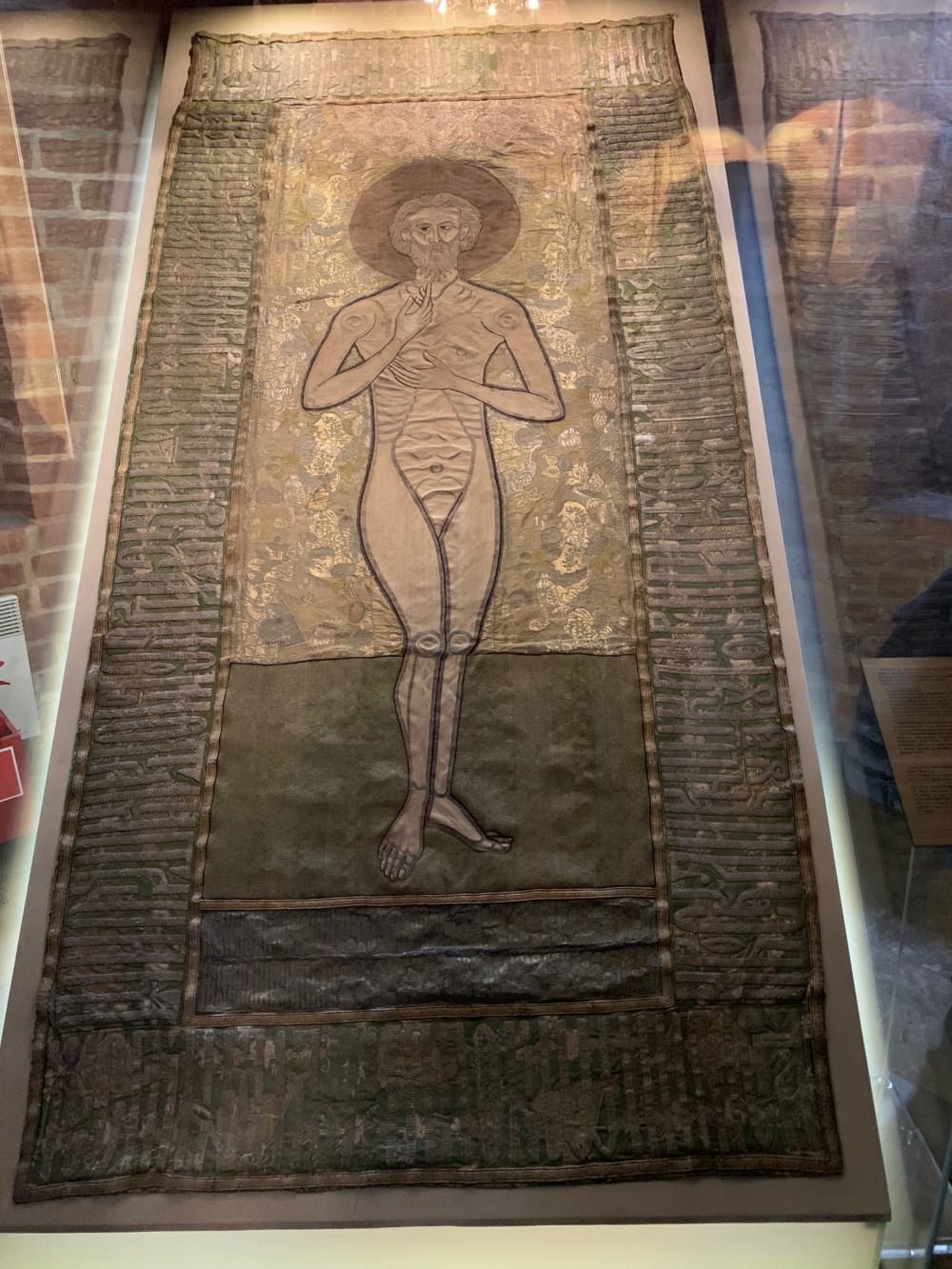
During our tour of St. Basil’s we were fortunate to see and hear the Doros male vocal ensemble. Their performance is in the brief video below (please pardon the red-headed fellow tourist who stepped in front of the camera).
Red Square at Night
The buildings that make up Red Square are all lit up at night by spotlights on adjacent buildings. St. Basil’s Cathedral is lit from all sides.
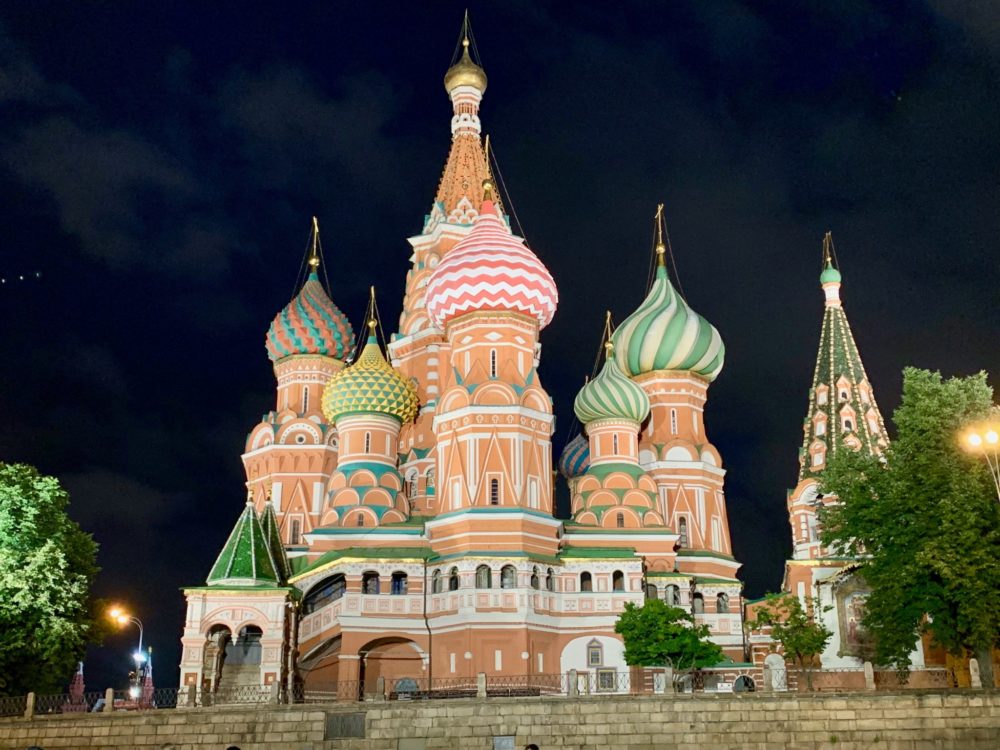
Many of the spotlights are on the GUM Department Store building, and its silhouette is wrapped in bulbs.
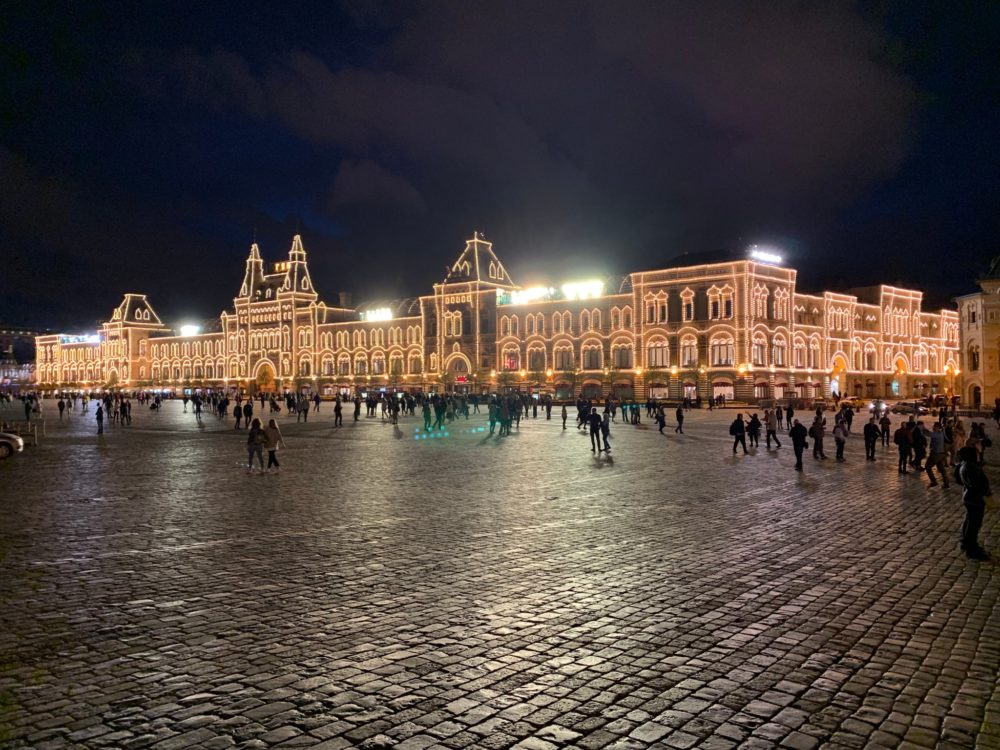
The State Historical Museum and part of the Kremlin at the opposite end of Red Square from St. Basil’s are also well lit.
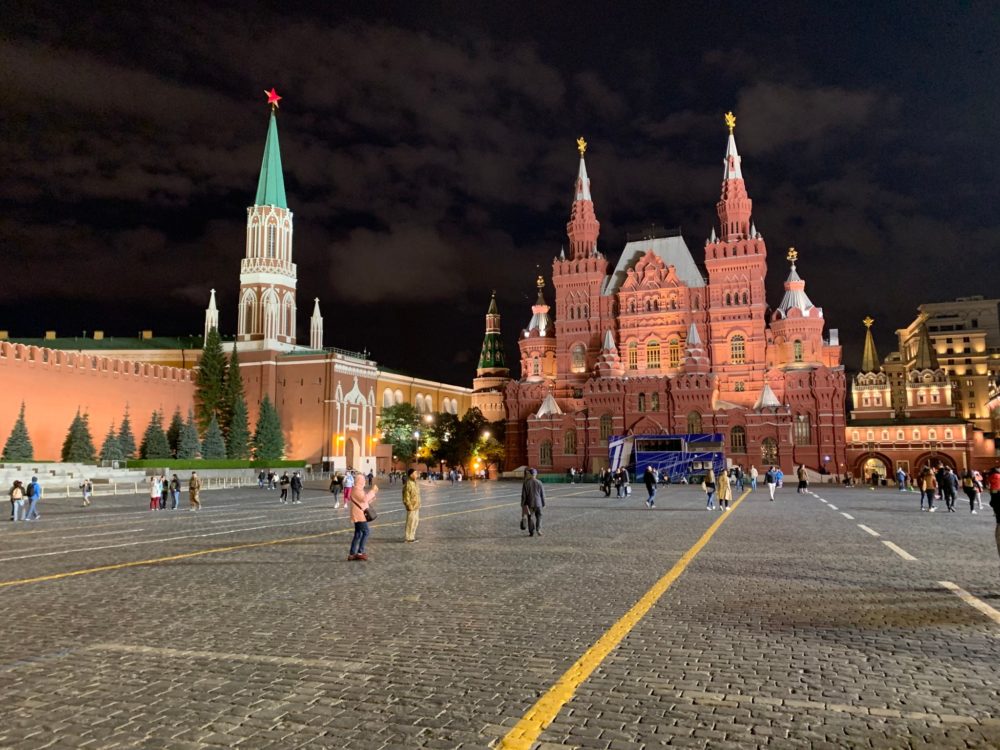
Below is a video looking at all of Red Square at night.
During the World Cup Football/Soccer matches in Russia, Christmas-like lights were strewn down several streets, including the main one leading into Red Square. This got such a great reception that they are now on year round.
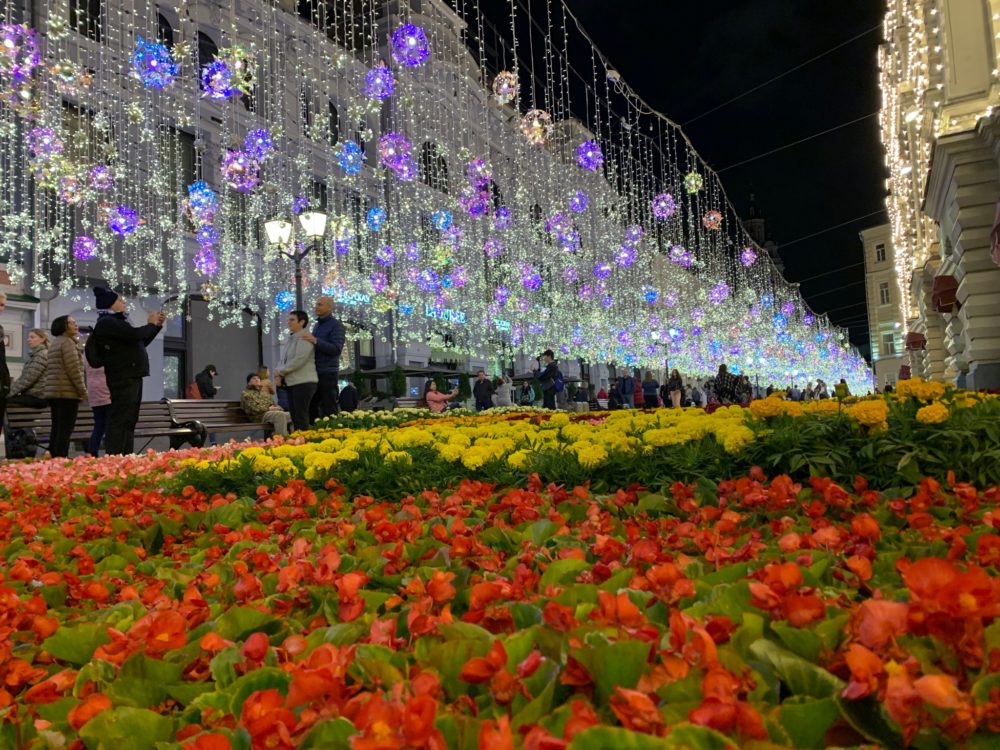
The Kremlin
Kremlin means citadel or fortress, and the Kremlin in Moscow certainly looks the part of a walled fortress with towers and gates.
There is nothing accidental about the Kremlin’s current appearance, from the chaos of its golden roofline to the overwhelming mass of palaces and ancient walls. Someone designed these shapes to celebrate the special character of Russian culture, and someone else approved the plans to go on building in a style that would suggest historically rooted power. The ubiquitous gold, in Orthodox iconography, may be a reminder of eternity, but for the rest of us it is also an impressive reflection of earthly wealth. From the churches and forbidding gates to the familiar spires that are its emblem, the Kremlin is not merely home to Russia’s rules. It is also theatre and a text, a gallery that displays and embodies the current governing idea.3
There is no reliable record of when the Kremlin building began. The present structure was built in the end of the fifteenth century.
The Kremlingard map shows how the Kremlin appeared in the later 16th century. Note the moats surrounding it (no Red Square!).
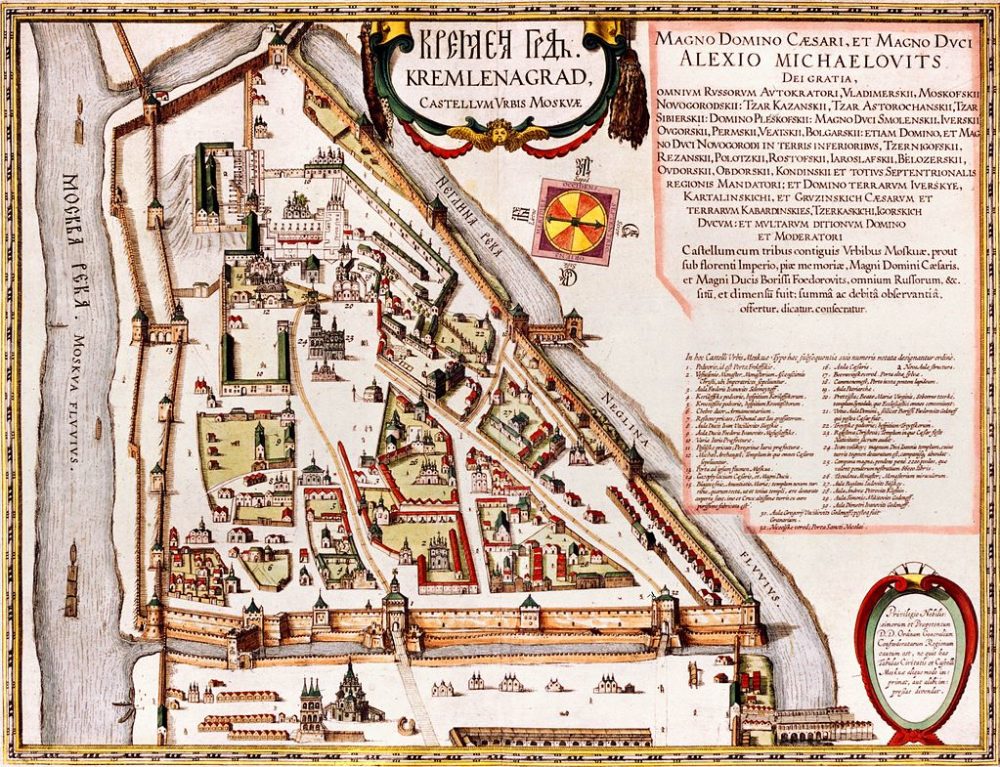
When Napoleon attacked Moscow, the Russian Army burned most of the city. Napoleon had to escape the Kremlin, but came back after the fires died down. “In the midst of the desolation, the Kremlin still stood more or less intact, a symbol to Russians, a landmark for the homeless and a magnet for the returning French. Napoleon moved back to the citadel on 18 September.”4
As Napoleon left on October 19, he had the Kremlin mined. While there were damages the explosions did not destroy the Kremlin.
During our tour we entered through Borovitskya Tower (number 4 in the map below) and exited through Spasskaya Tower (number 5) into Red Square. For perspective, the Alexander Garden is outside towers 3 and 4 in the map, St. Basil’s Cathedral can be seen exiting gate 5, and Lenin’s Mausoleum is to the left as you exit gate 5.
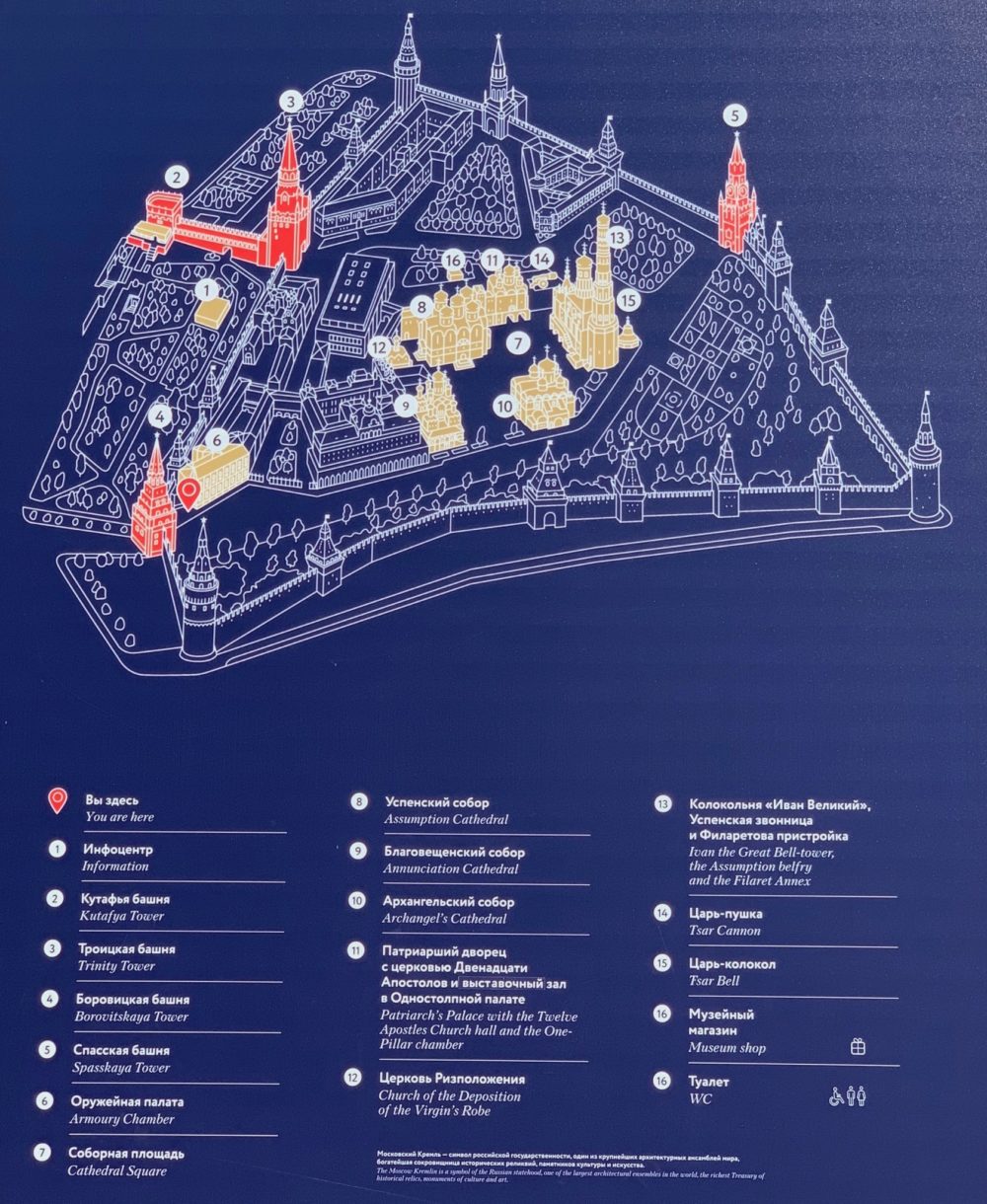
Kremlin Armoury Museum
TheKremlin Museumis in the Armoury (building 6 in the map above). We were one of the first groups in, and the emptiness gave the museum a somewhat old feeling. Unfortunately no photography is allowed. The Armoury not only houses armor, firearms and other implements of war, but has several other collections. There are tenFaberge Imperial Easter Eggsin the Kremlin Armoury museum, one more than is in the Faberge Museum in Saint Petersburg. There is an extensive collection of carriages used by Russian rulers. There is a collection of robes and dresses worn by queens and princesses. And there is a collection of gifts from other countries to Russia.
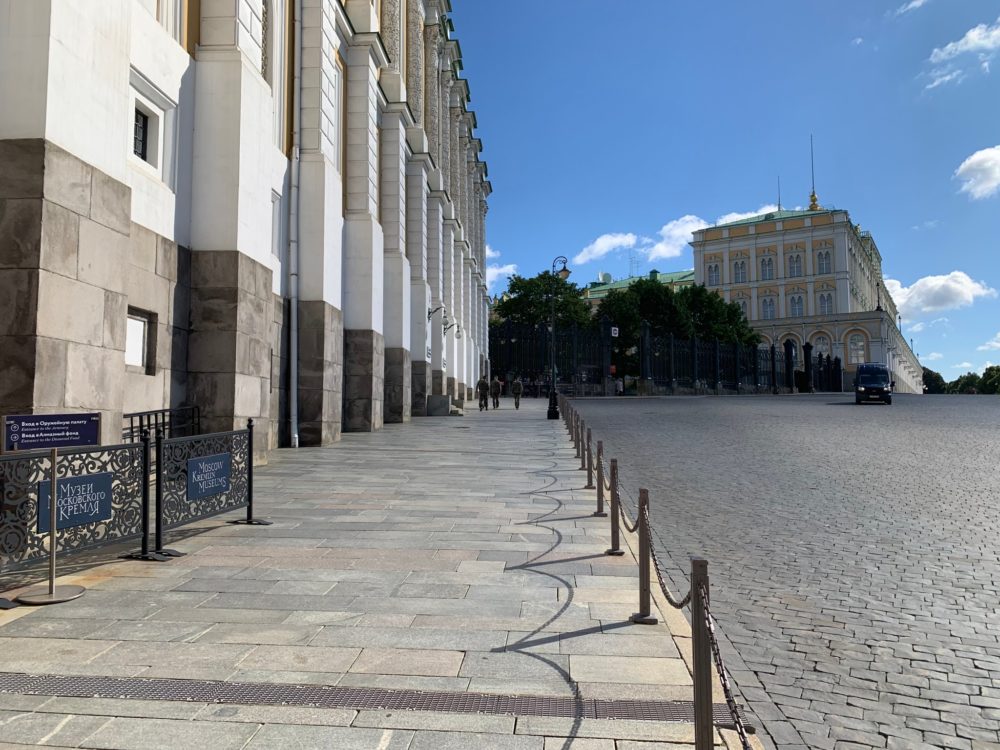
Cathedral Square in the Kremlin
From the Kremlin Armoury Museum we went to Cathedral Square. As can be seen in the map, there are multiple cathedrals that surround this square. When I asked why, I was told that different types of people went to different churches. The video below starts facing the Annunciation Cathedral, then pans right to the Dormition Cathedral (also called the Assumption Cathedral), and finally ends at the Archangel Cathedral.
The Annunciation Cathedral is the first Cathedral encountered walking from the Kremlin Armoury Museums.
The Dormition Cathedral, also known as the Assumption Cathedral, was the main cathedral of the Tsardom of Russia. The main construction of the cathedral was in the late 1400s. It is also the burial place of Moscow Metropolitans and Patriarchs. Russian monarchs were coronated in this cathedral until 1896.
The photo below faces the southern gate which is the main gate. This gate was used for the Tsar’s processions. The top image (somewhat shaded in the photo below) is of the Holy Virgin of Vladimir.
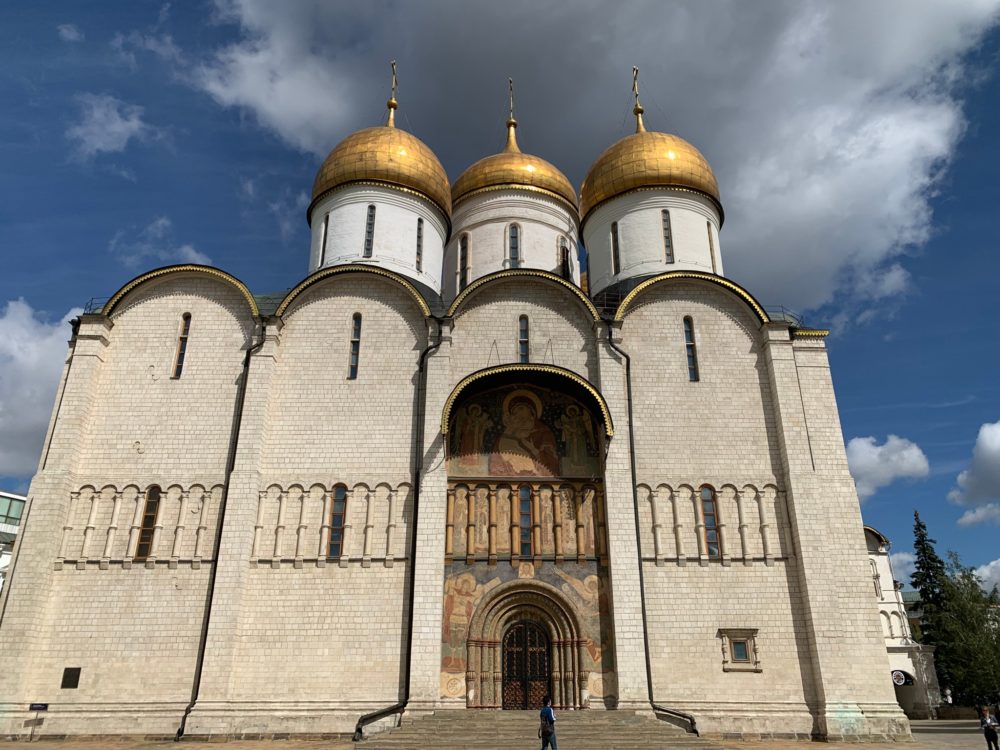
There is no photography allowed in the cathedrals, but the Kremlin Museum does provide short guides – in English even! Below is a scan of the front page, showing the door we entered (the Western portal) and many other points of interest.5
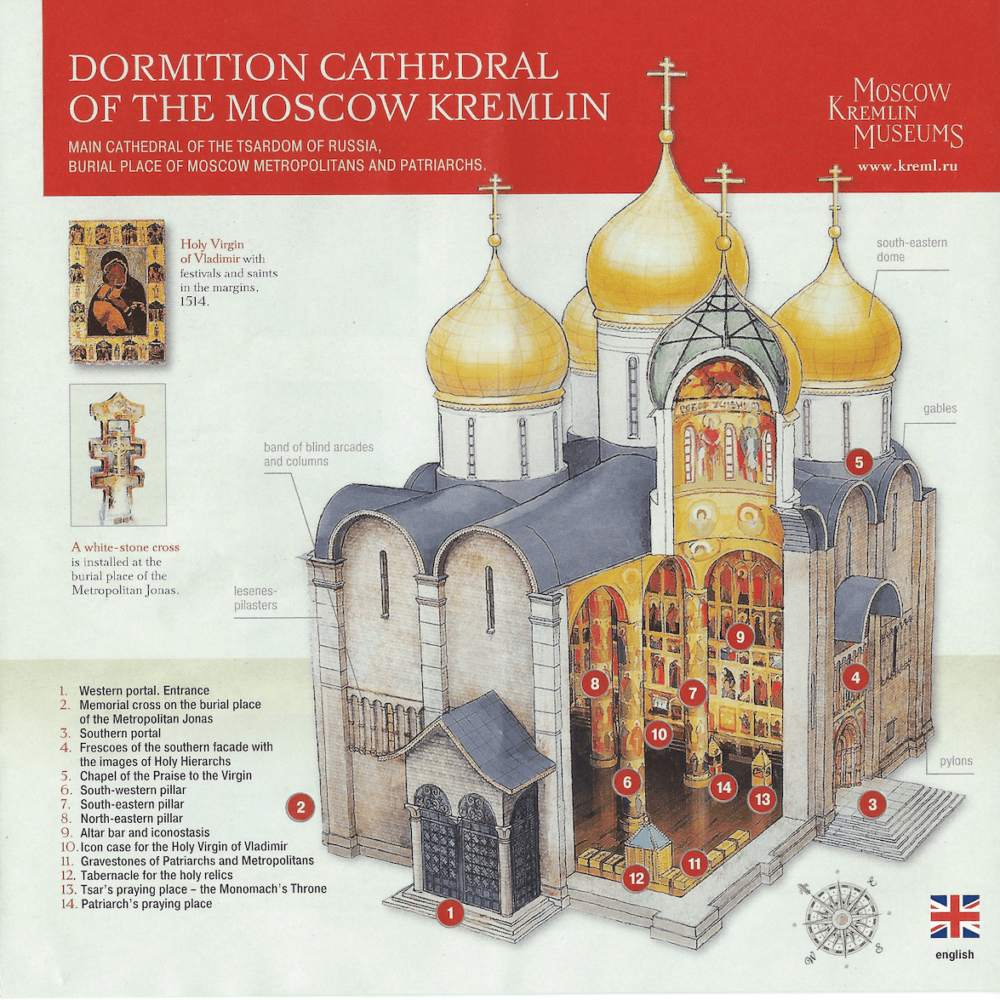
Below is a scan of the map depicting the interior of the Dormition Cathedral.6
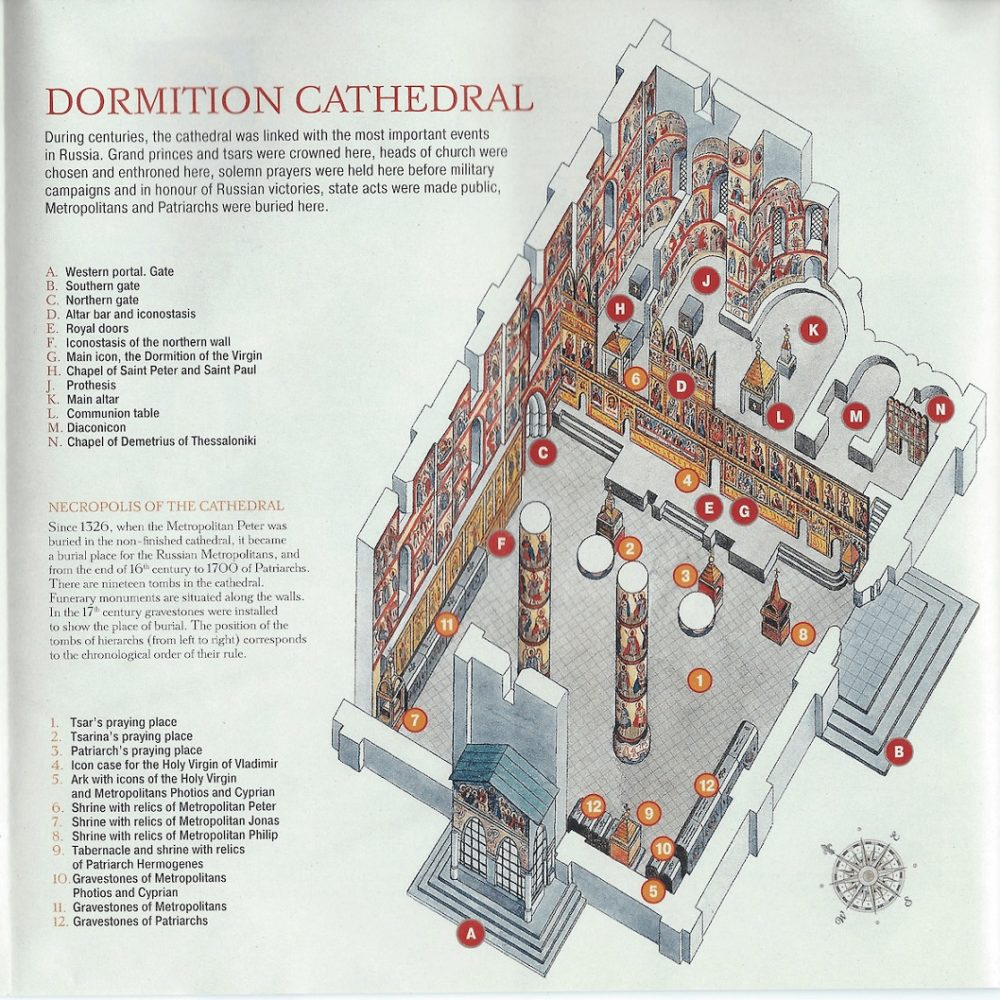
The video below begins centered on the Dormition Cathedral, then pans right to the Bell Tower. The final cathedral is the other side of the Archangel Cathedral.
The Archangel Cathedral was the other cathedral that we were allowed inside. Again, no photography, but a nice English brochure. Below is a scan of the front page depicting the exterior.7
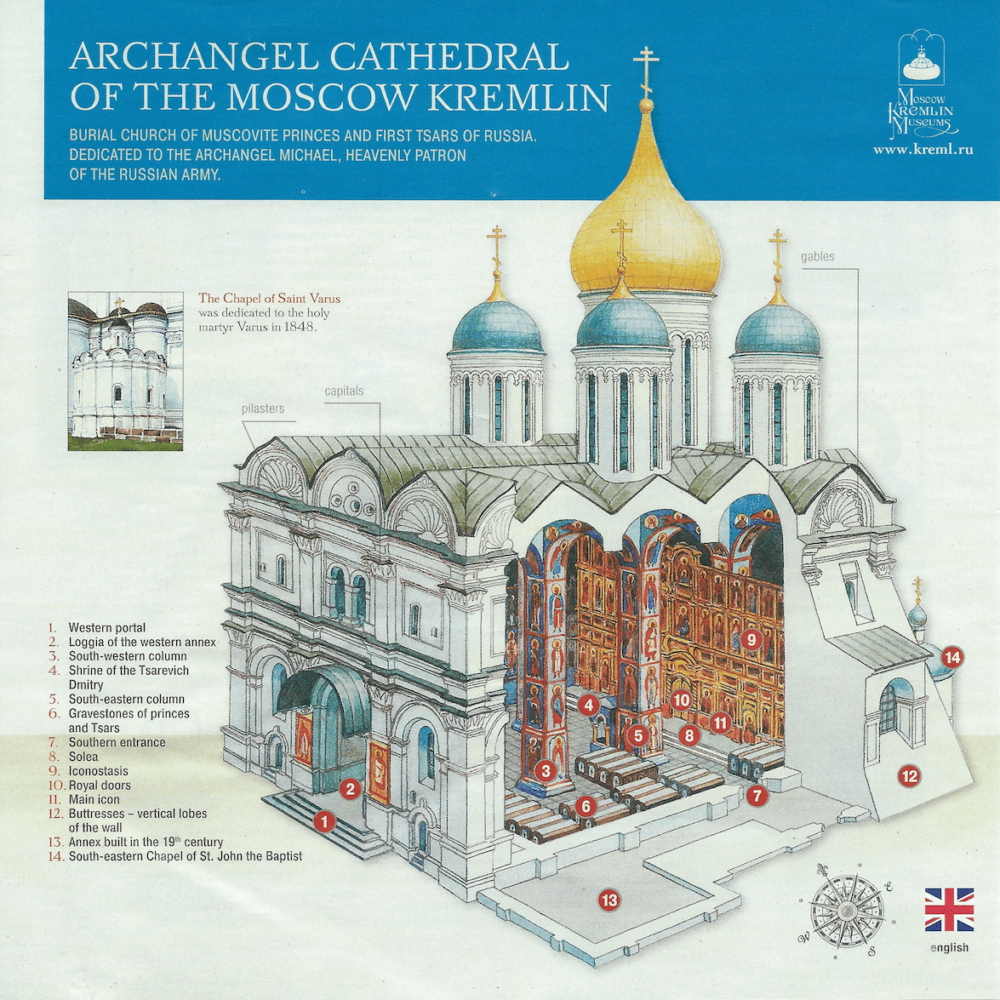
Below is a scan of an inside page of the brochure depicting the interior.
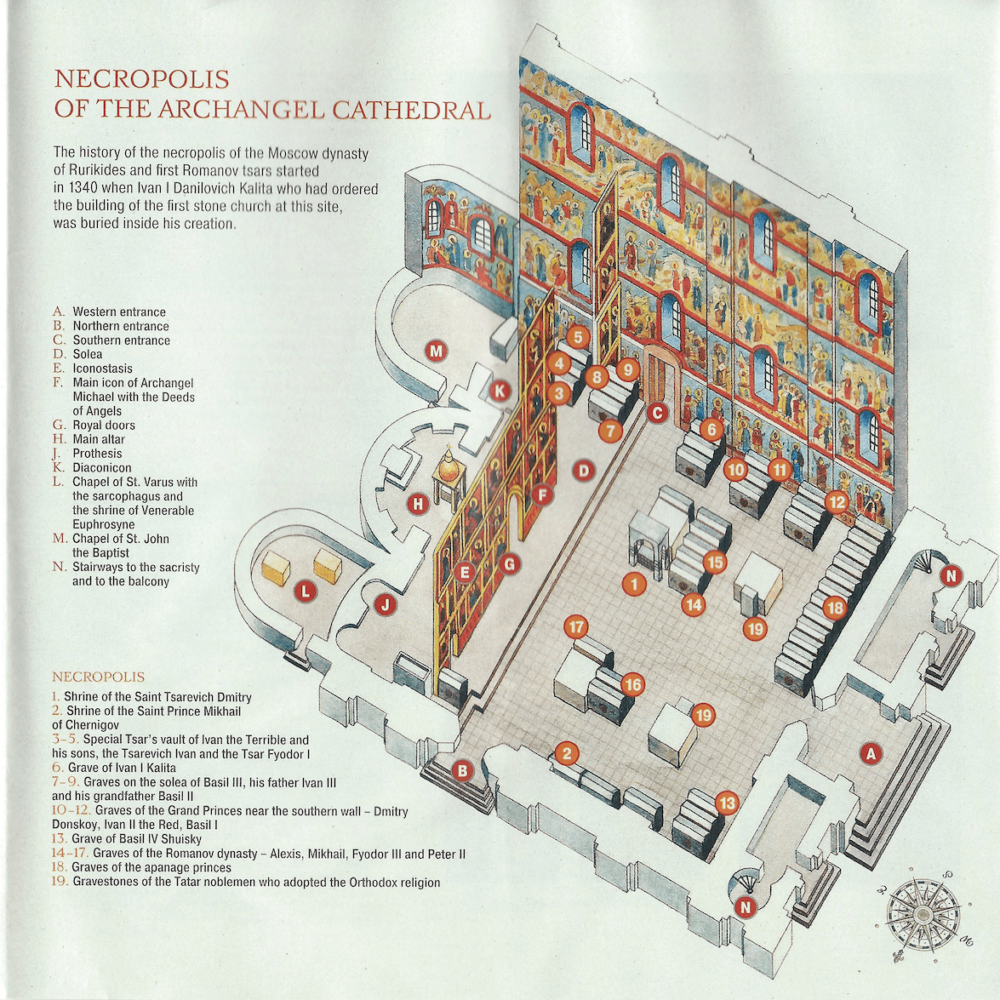
The tallest building in the square is the Ivan the Great Bell Tower, seen below.
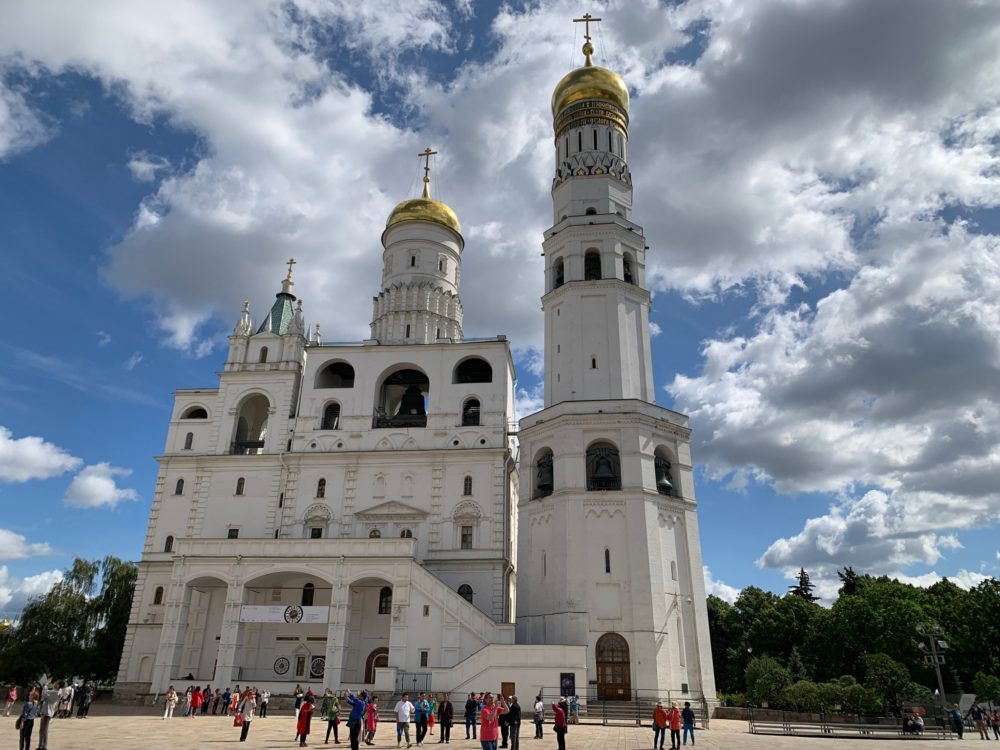
Tsar Bell, Cannon and Presidium
The Tsar Bell and the Tsar Cannon site between Cathedral Square and the Square in front of the Kremlin Senate building, the Presidium. Voltaire is quoted as saying the greatest items in the Kremlin are a bell that was never rung and a cannon that was never fired.
The Tsar Bell cracked due to a fire shortly after it was cast. The bell was cast in 1735 and was cooling through 1737 (big bell, takes a like time to cool!) when a fire broke out. Some who were trying to put out the fire threw water on the bell, cracking it and causing the large slab to break off. It fell back into the pit from whence it was cast, and wasn’t pulled out until 1836.
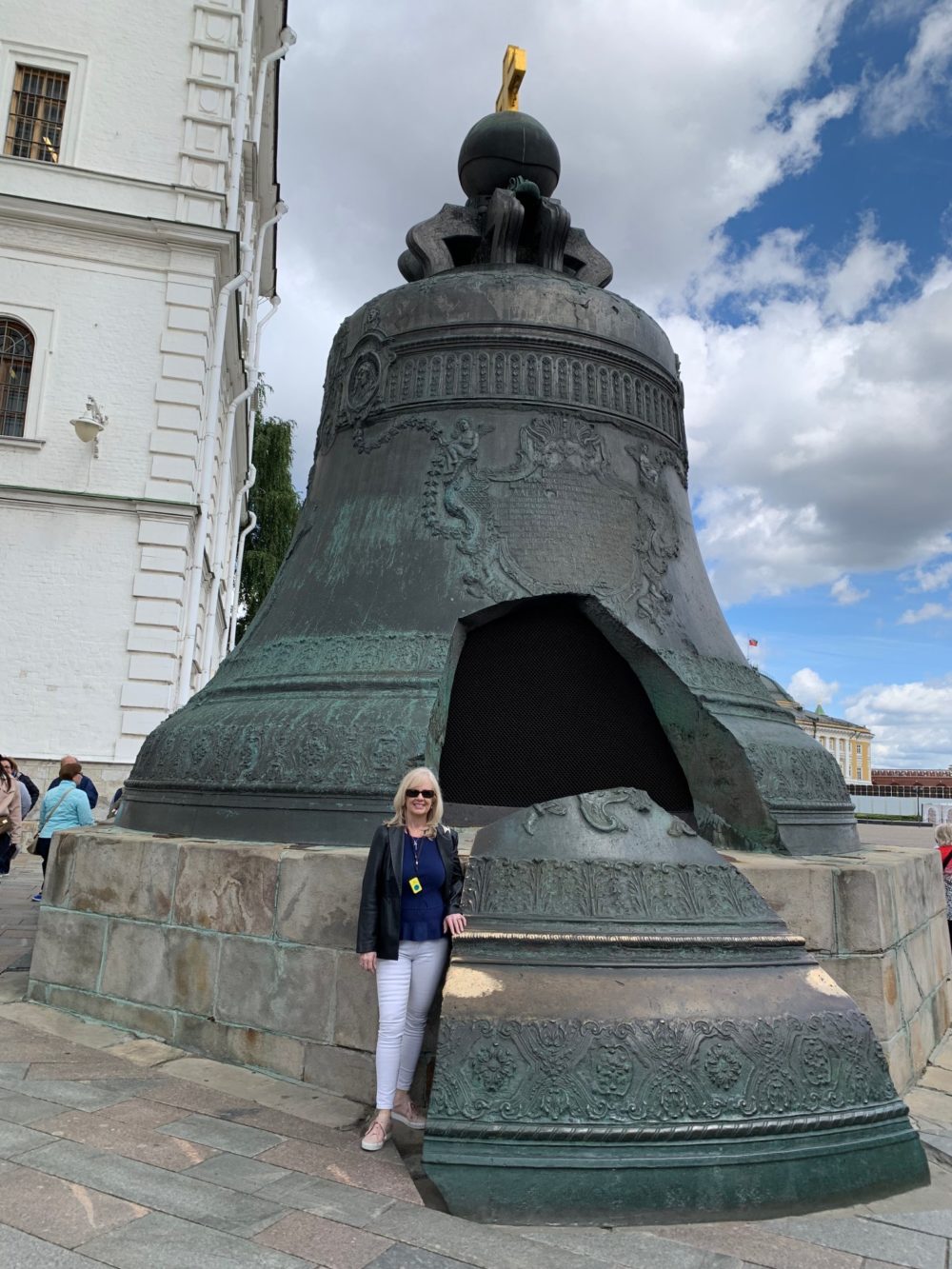
The Tsar Cannon dates from 1586. Classified as a mortar weapon as opposed to a cannon, it was never used in a war. It is the largest “bombard” by caliber (890mm) in the world.9.
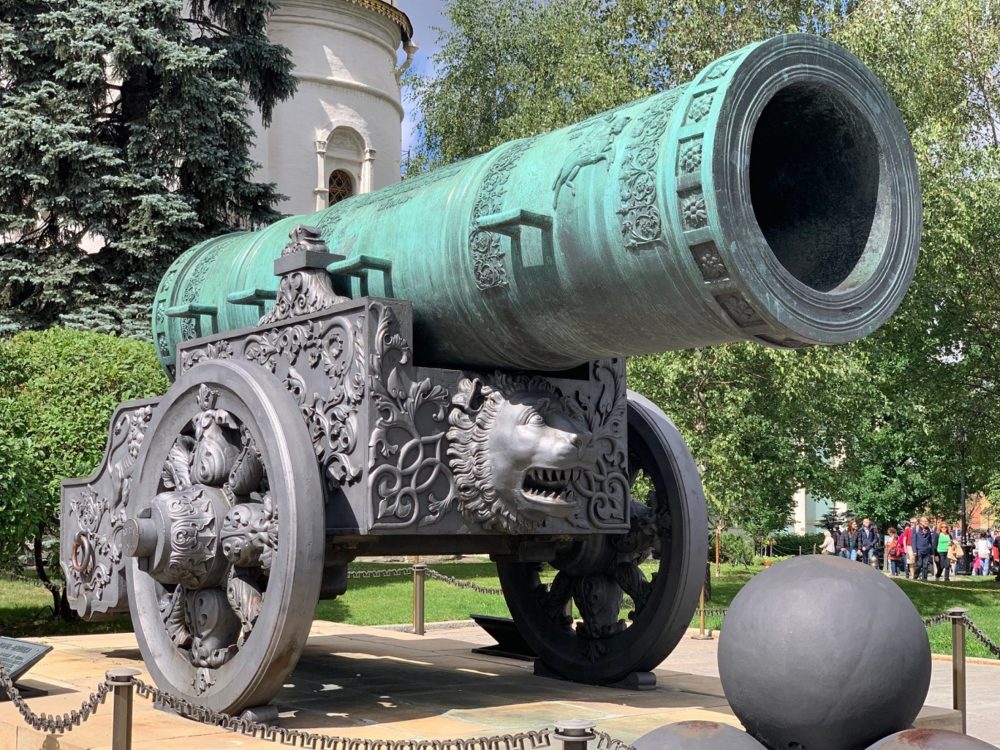
The picture below shows the position of the cannon, with the Dormition Cathedral with the gold domes on the left and the Patriarch’s Palace with the silver domes on the right.
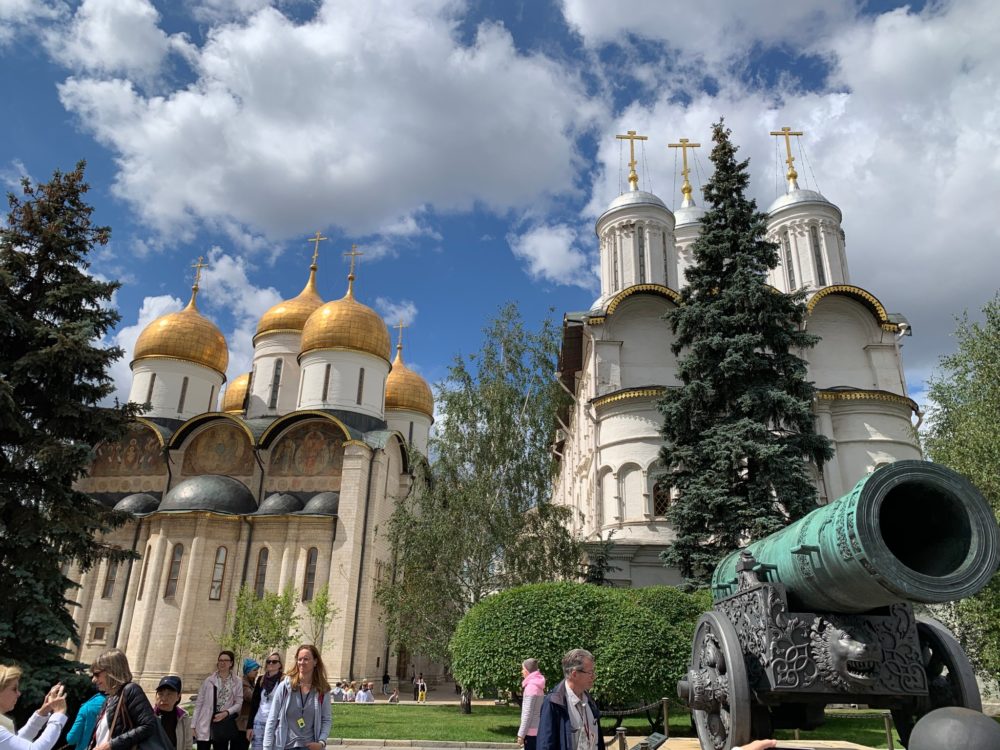
Interestingly, the Tsar Cannon faces toward the square where the Presidium building stood until it was demolished in 2016. In the photo below the yellow building on the left is the Kremlin Senate. The tower on the right is Spasskaya Tower. The gate under the tower exits into Red Square, just to the right of Lenin’s Mausoleum and in front of St. Basil’s Cathedral.
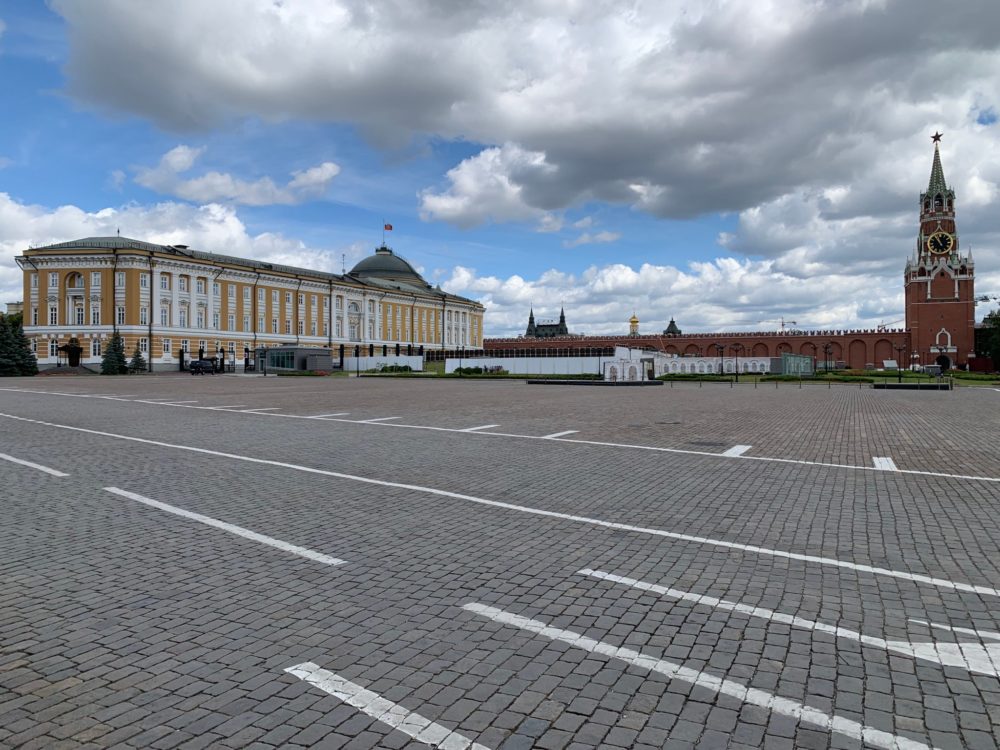
Alexandrovsky Garden
The garden on the other side of the Kremlin, opposite from Red Square, is the Alexandrovsky Garden. The information below is from a sign in the Garden.
«Alexandrovsky Garden was laid out by the order of Emperor Alexander I during the restoration of the city after the war with Napoleon in 1812. Its construction lasted from 1819 to 1823. Alexandrovsky Garden, known as the Kremlin Garden at the time, was designed by architect Osip Bove after the Neglinka River, which used to run on the grounds along the Kremlin Wall, was channeled into underground pipes.»
In 1856 the garden was renamed in honor of Emperor Alexander I. Today the total area of Alexandrovsky Garden is 10 hectares, the same as it was in the past centuries.
The Tomb of the Unknown soldier, dedicated to the soldiers lost in World War II (referred to in Russia as the Great Patriotic War) is near the entrance to the Garden. Interred in the tomb are remains from soldiers killed at the 40 kilometer on the Leningrad highway – the closest that Germany got to Moscow in 1941. The tomb is placed up against the Kremlin wall. There is supposedly a guard change, but we were there later at night.
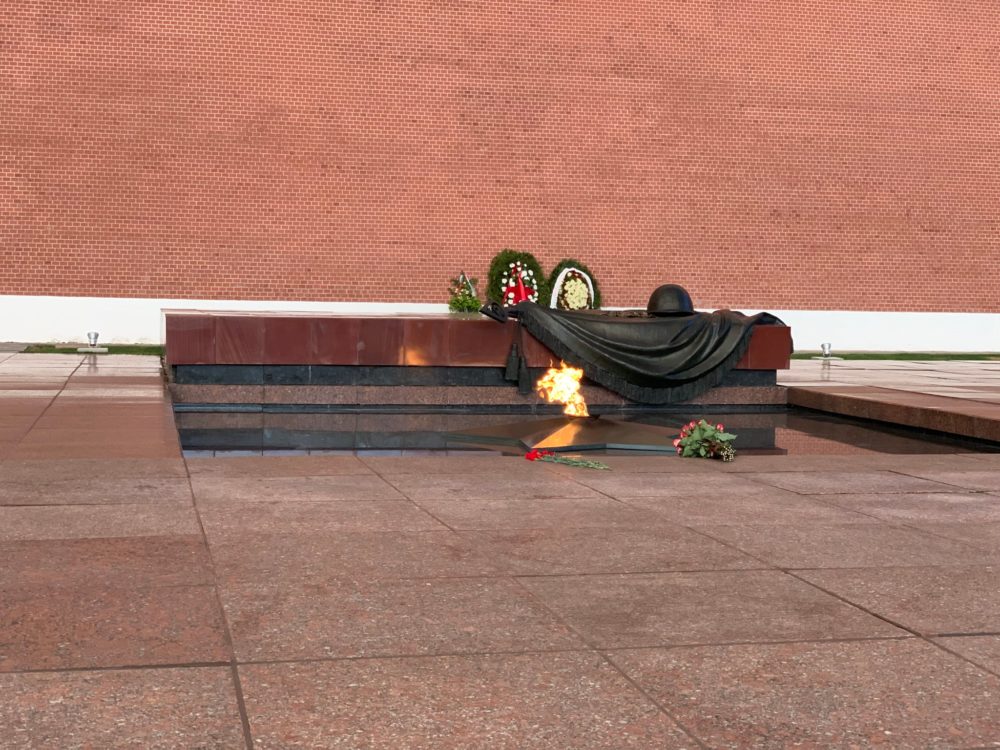
Slightly further down from this Tomb is the Grotto. It was built in 1841 to commemorate Russia’s victory over Napoleon in 1812. It is probably not coincidental that these two monuments (the Grotto and the Tomb) to two Russian victories stopping invaders from reaching Moscow are situated close together!
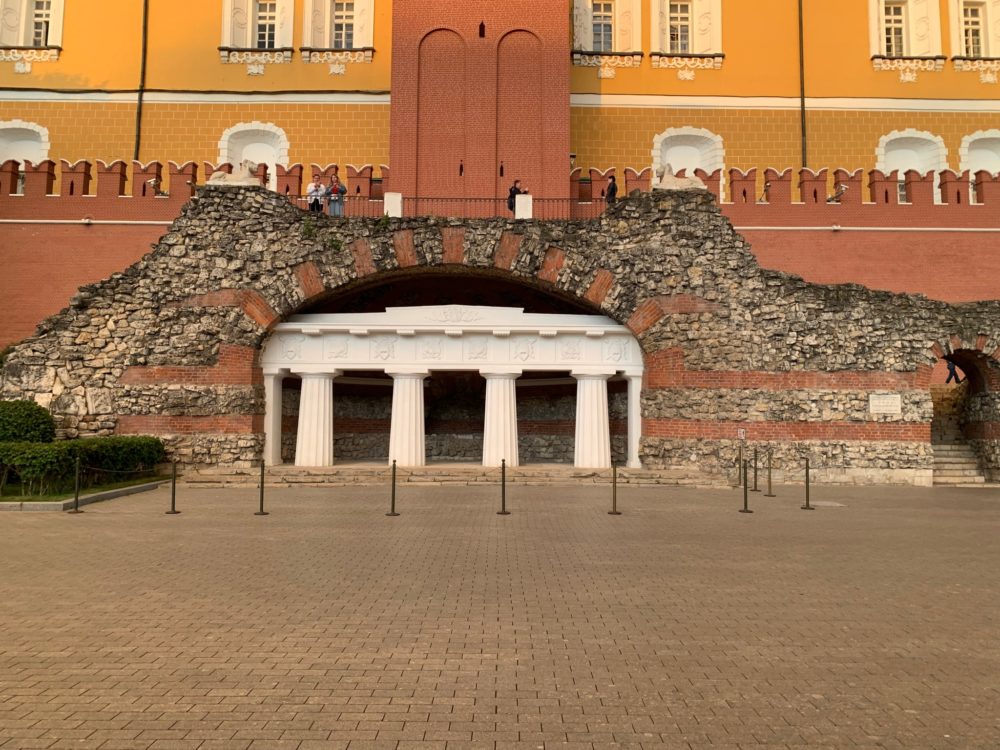
There are several statues spread throughout the garden, including this one of thePatriarch Hermogenes, who start the uprising to lead Russia out of the “Time of Troubles.” In 1610 he urged Russians to rise up against Polish invaders. He was arrested, beaten and starved to death.
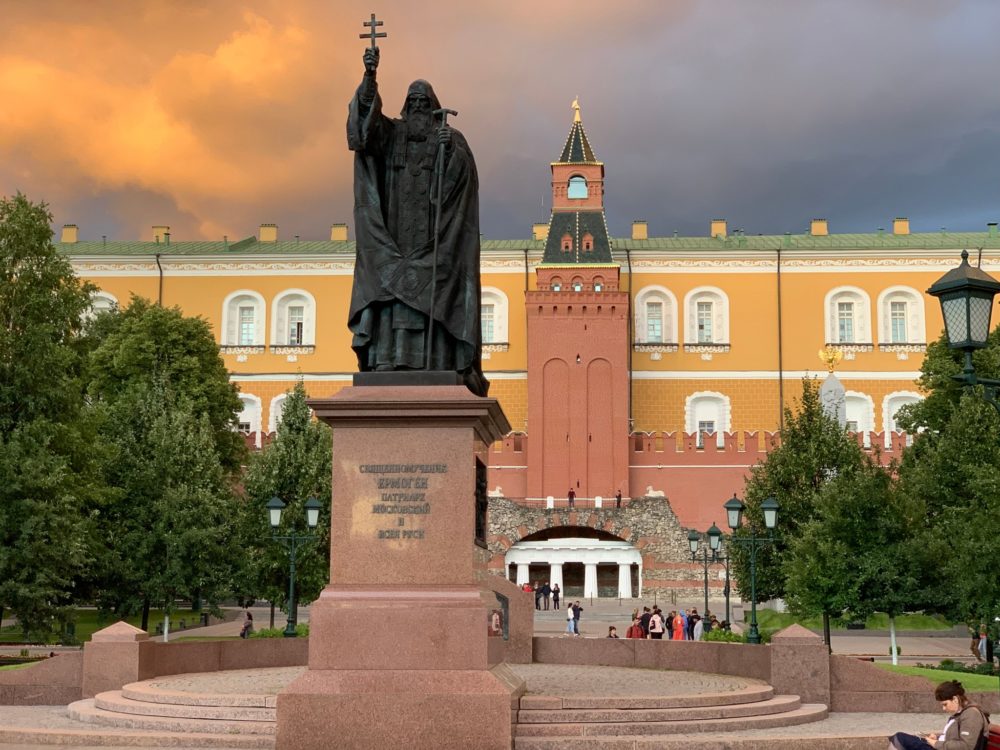
There are many amazing statues of horses all over Russia. Or that’s how it seemed. I may have to write an article just on the horse statues in Moscow and Saint Petersburg. In the Alexandrovsky Garden, the horse statues are in the middle of several fountains.
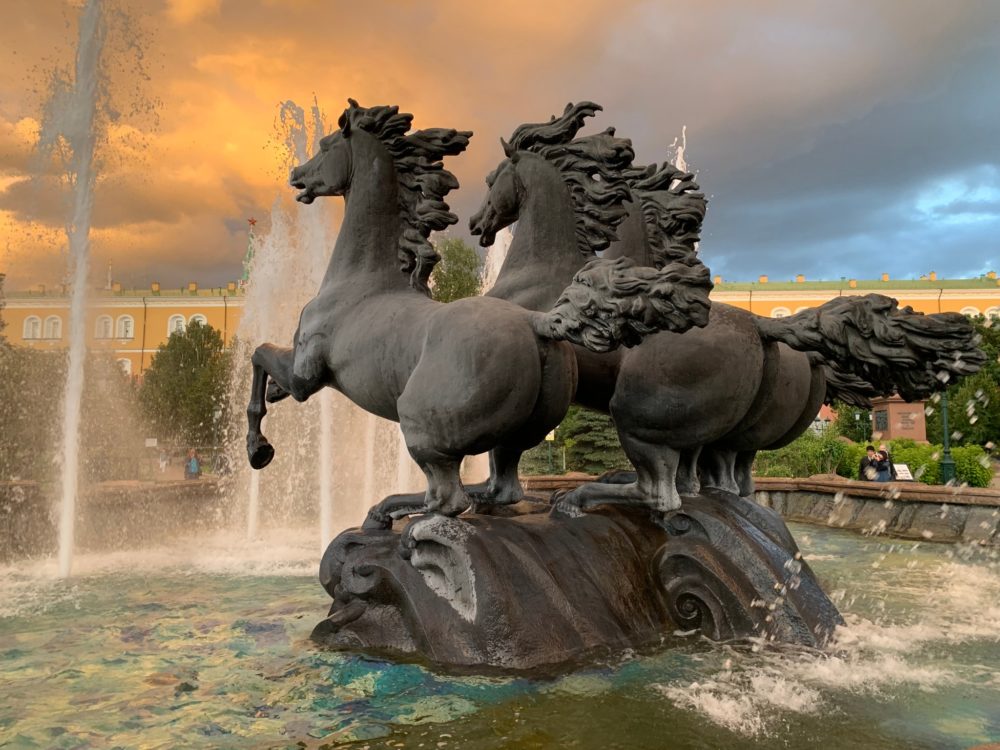
Below is a video that shows the fountains in motion.
Cathedral of Christ the Savior
The Cathedral of Christ the Savior is a short walk from the Kremlin. The gold towers of this Cathedral can be seen from the Kremlin and vice versa. Originally opened in May 1883, in 1931 the Cathedral of Christ the Savior was demolished by the Soviets who aimed to use the site to build a massive “Palace of the Soviets.” This was never built and Khrushchev commissioned a swimming pool to be built on the site. It was very popular, visited by over five million people a year. But the art museums on the same street complained of the effects of the humidity (heated pool) on the art works. The pool was closed and a replica of the original Cathedral was built, with its grand opening in 1997.
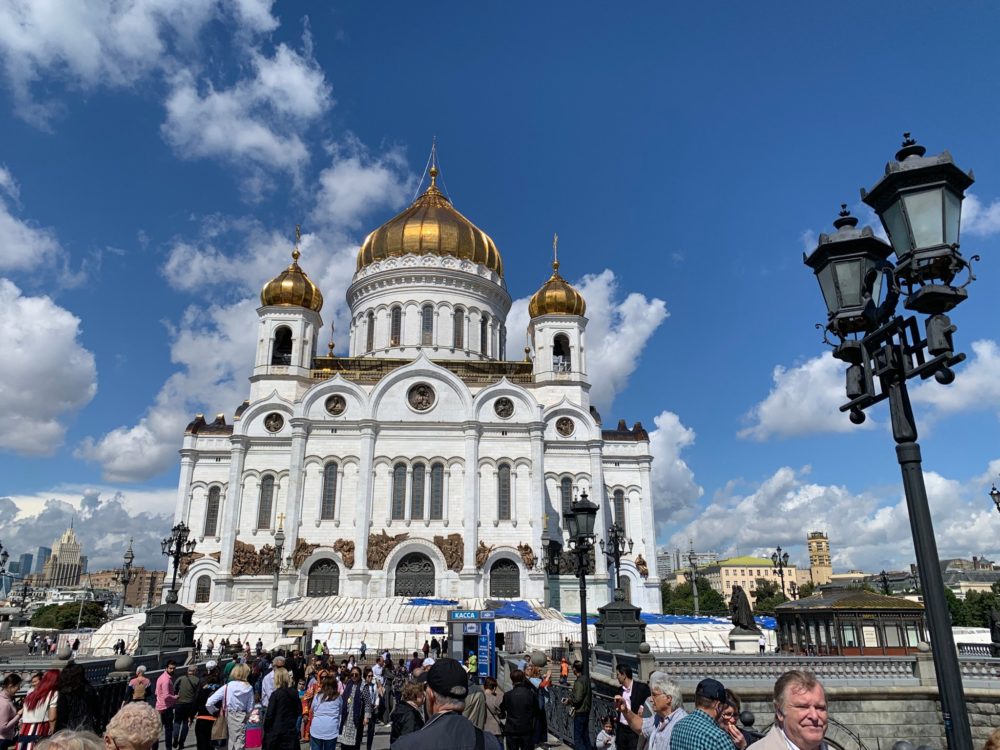
The new Cathedral was built very quickly. “To meet the self-imposed targets, Luzhkov’s (Moscow’s mayor at the time) architects used concrete instead of stone….The massive building was not quite a replica, in other words, but more like a vast, expensive fake.”10
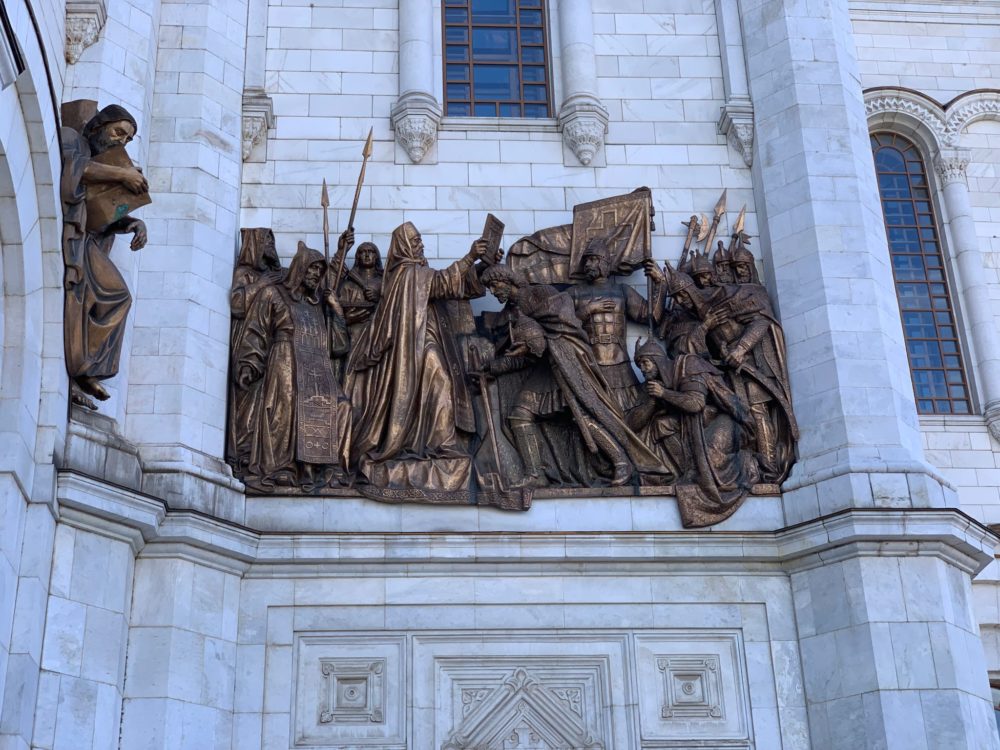
There were services being held when we visited and, in spite of its young age, it is as impressive inside as it is outside.
Statues and Monuments Near Red Square
Marshal Zuhkov statue
The monument to Marshal Zuhkov stands in front of the Russian Historical Museum, just outside of Red Square.
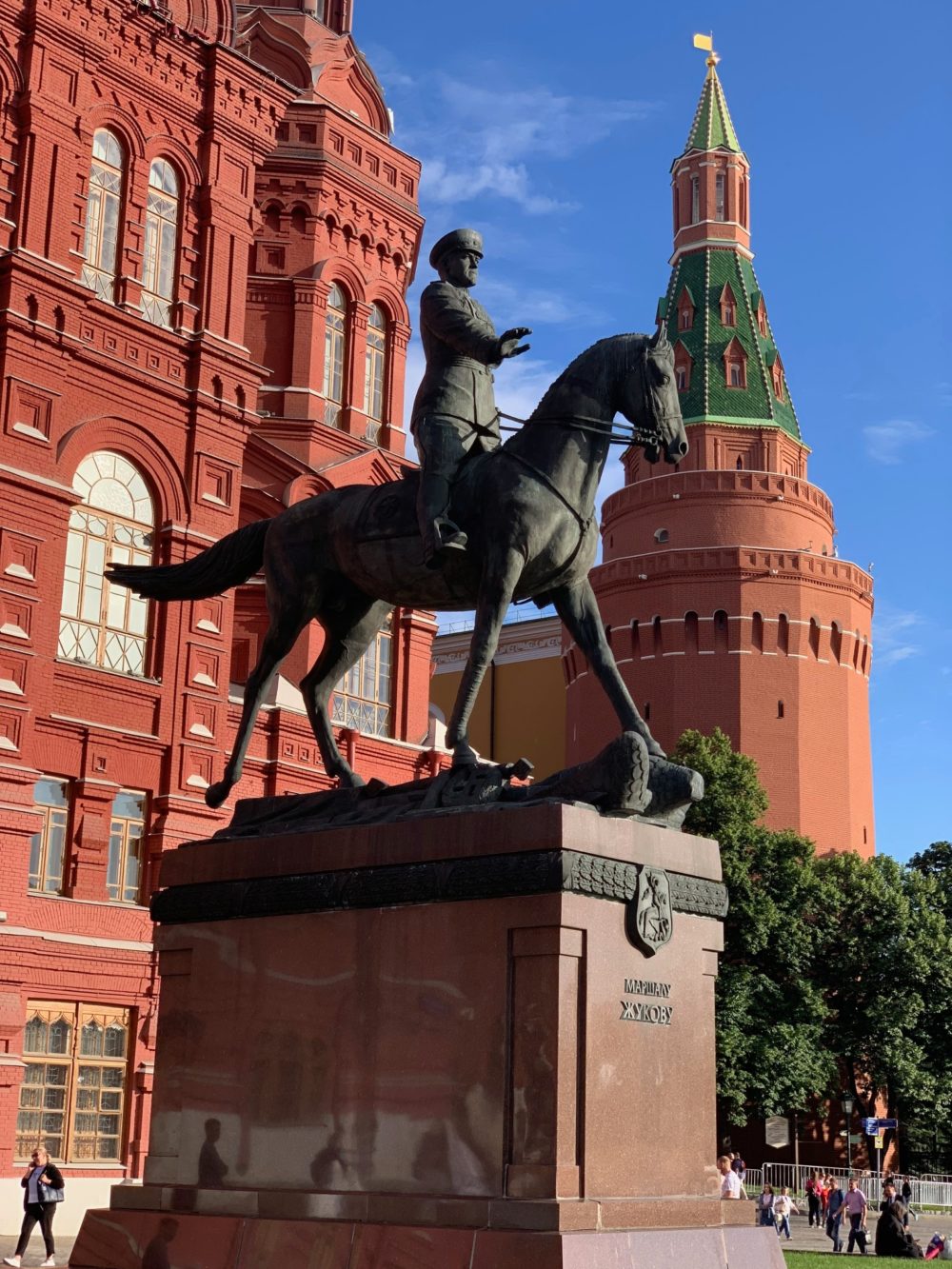
Vladimir the Great Statue
Just outside of the Alexander Garden is a newly erected status forVladimir the Great. It was erected in 2016 by Russian President Vladimir Putin. Like the next statue mentioned, this one is considered by some to be an eye-sore by some, as it size (17.5 meters high) and subject are out of place in its location.
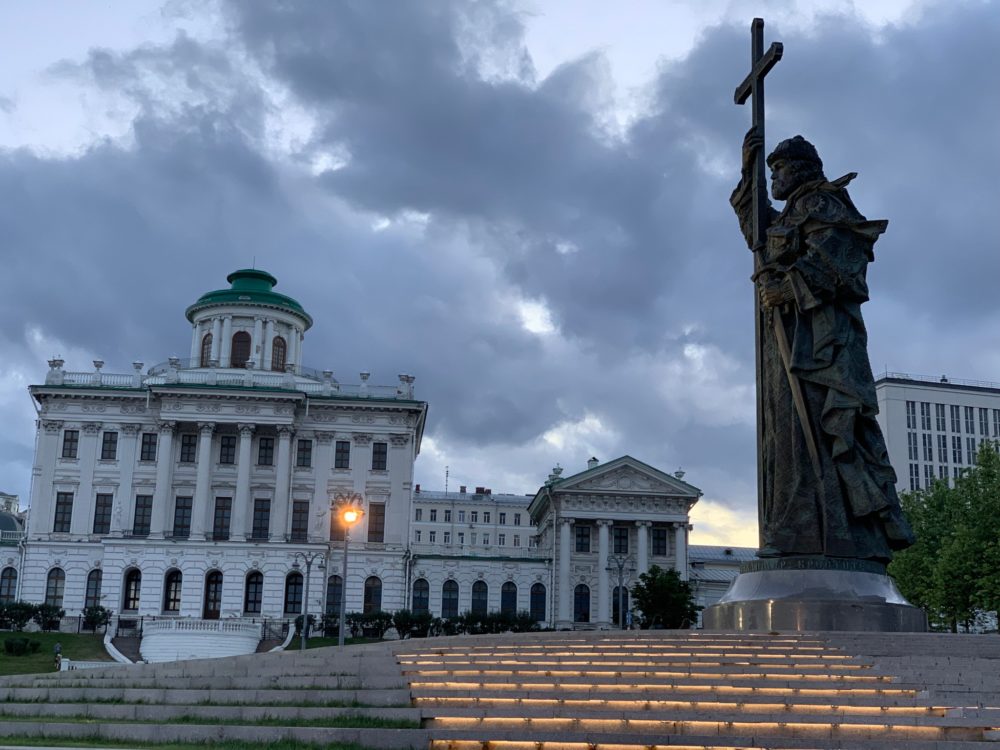
Peter the Great Statue
Visible from the bridge behind the rebuilt Cathedral of Christ the Savior, this statue of Peter the Great is massive – like everything else in Russia. I’ve read that it has been voted among the ugliest building and monuments in the world. It is certainly one of the tallest (322 feet tall).
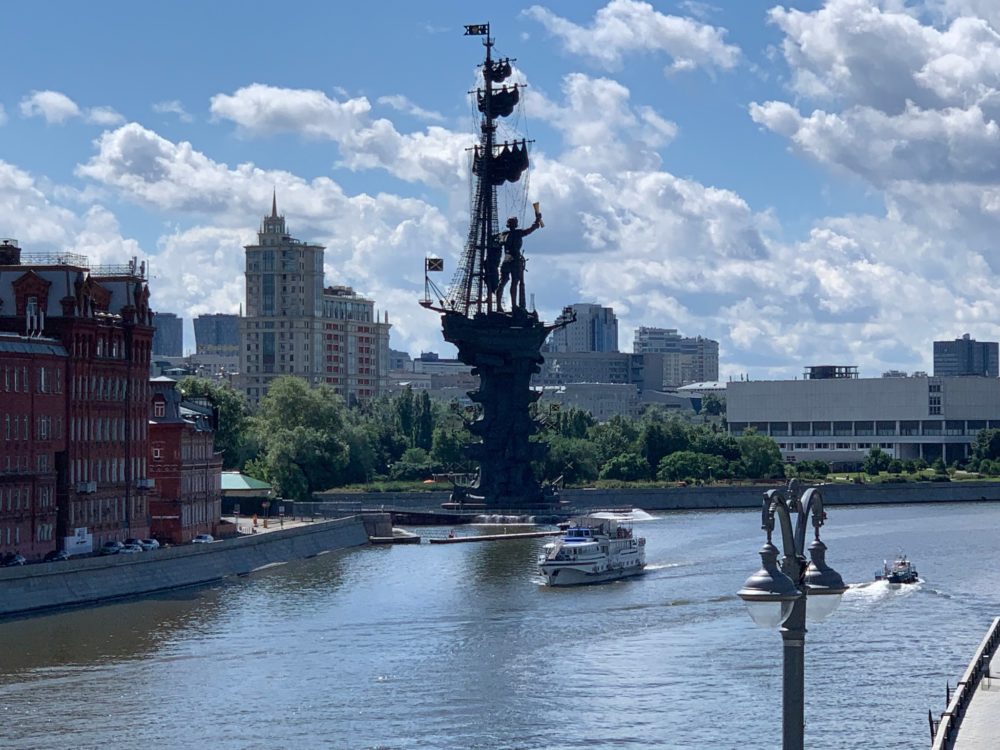
Here’s a photo of the front of the statue from a bridge
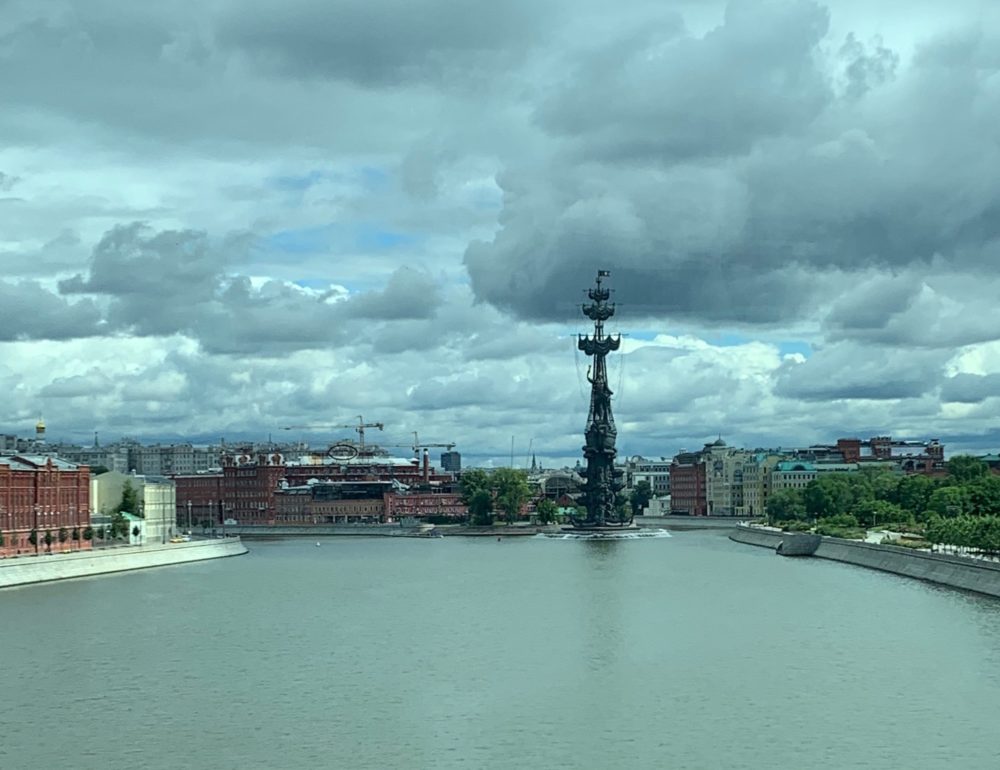
Museum of the Patriotic War of 1812
Next door to the Russian State History Museum, just outside of Red Square is the Museum of the Patriotic War of 1812. Opened in 2012, the museum houses a collection of uniforms, weaponry, maps, paintings and other memorabilia from the war between the Russian Army and Napoleon’s Grand Armee. One of the best paintings is by V.V. Vereshchagin, called Through the Fire. It depicts the events mentioned earlier of September 12, 1812, when the flames set to Moscow reached the Kremlin where Napoleon was staying and he had to be escorted out.
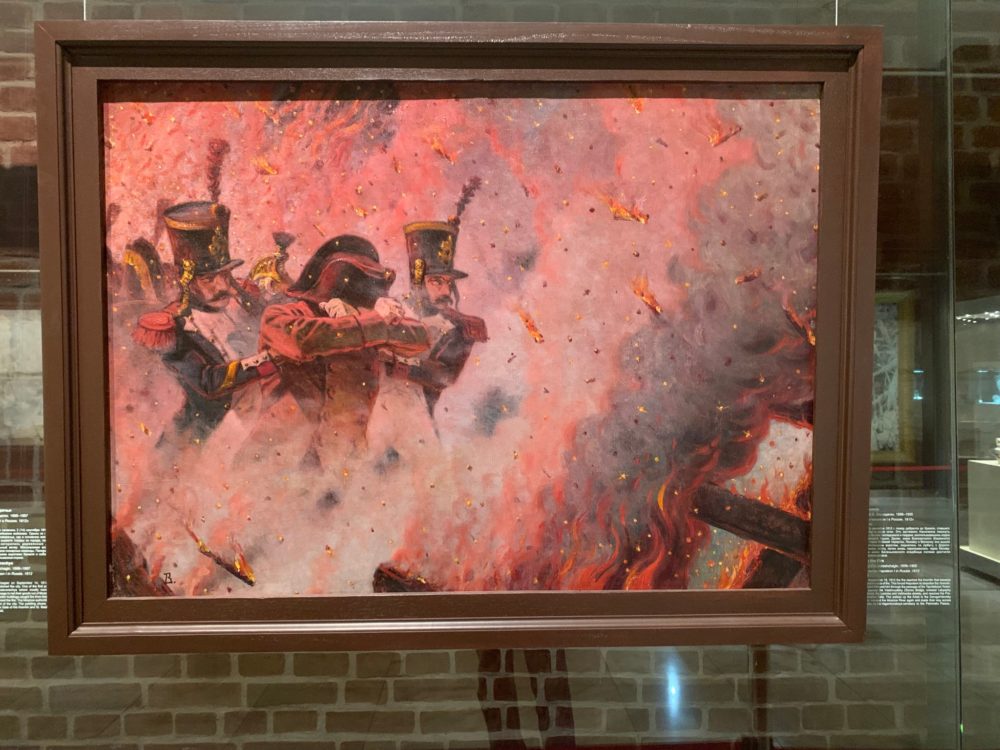
There is also a sled that, according to museum legend, is the one Napoleon rode in as he fled Russia in 1812.
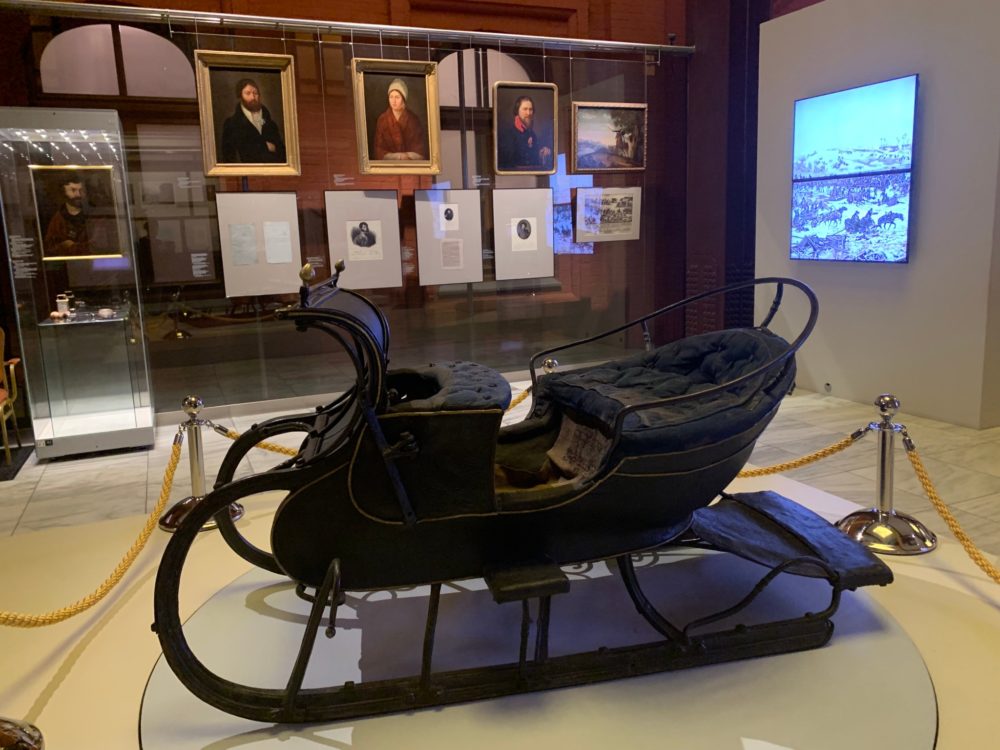
There are also many uniforms and armaments, such as this set of four howitzers that were recovered from the French Grand Armee.
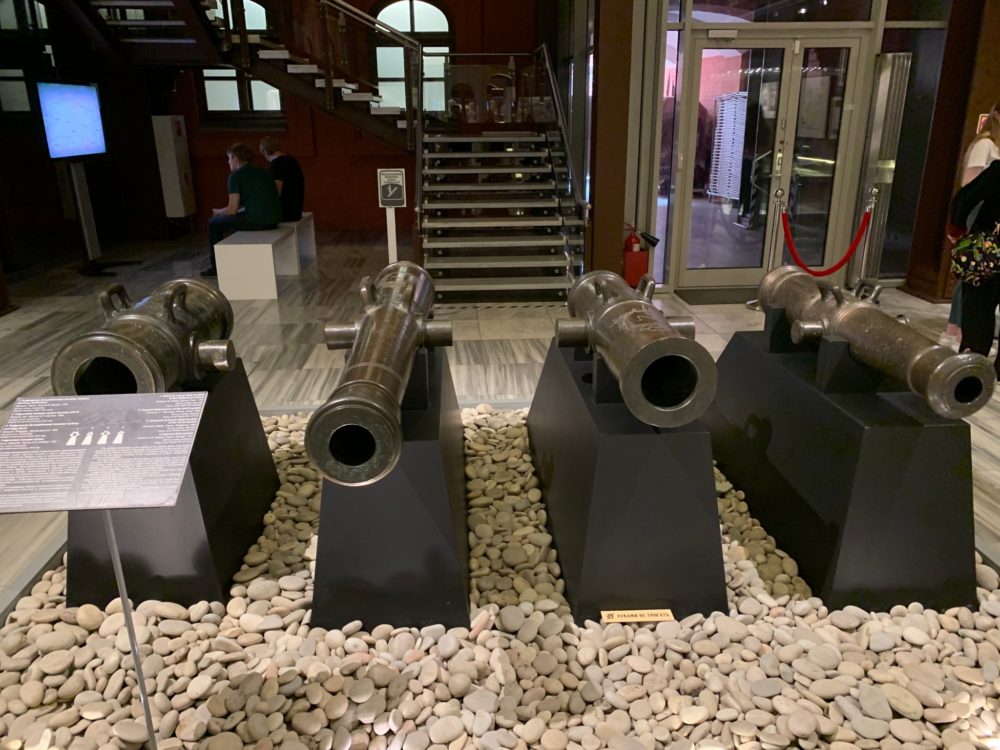
And, for some reason, in the middle of Moscow – this painting of a Russian Major General made me think of Bill Murray!
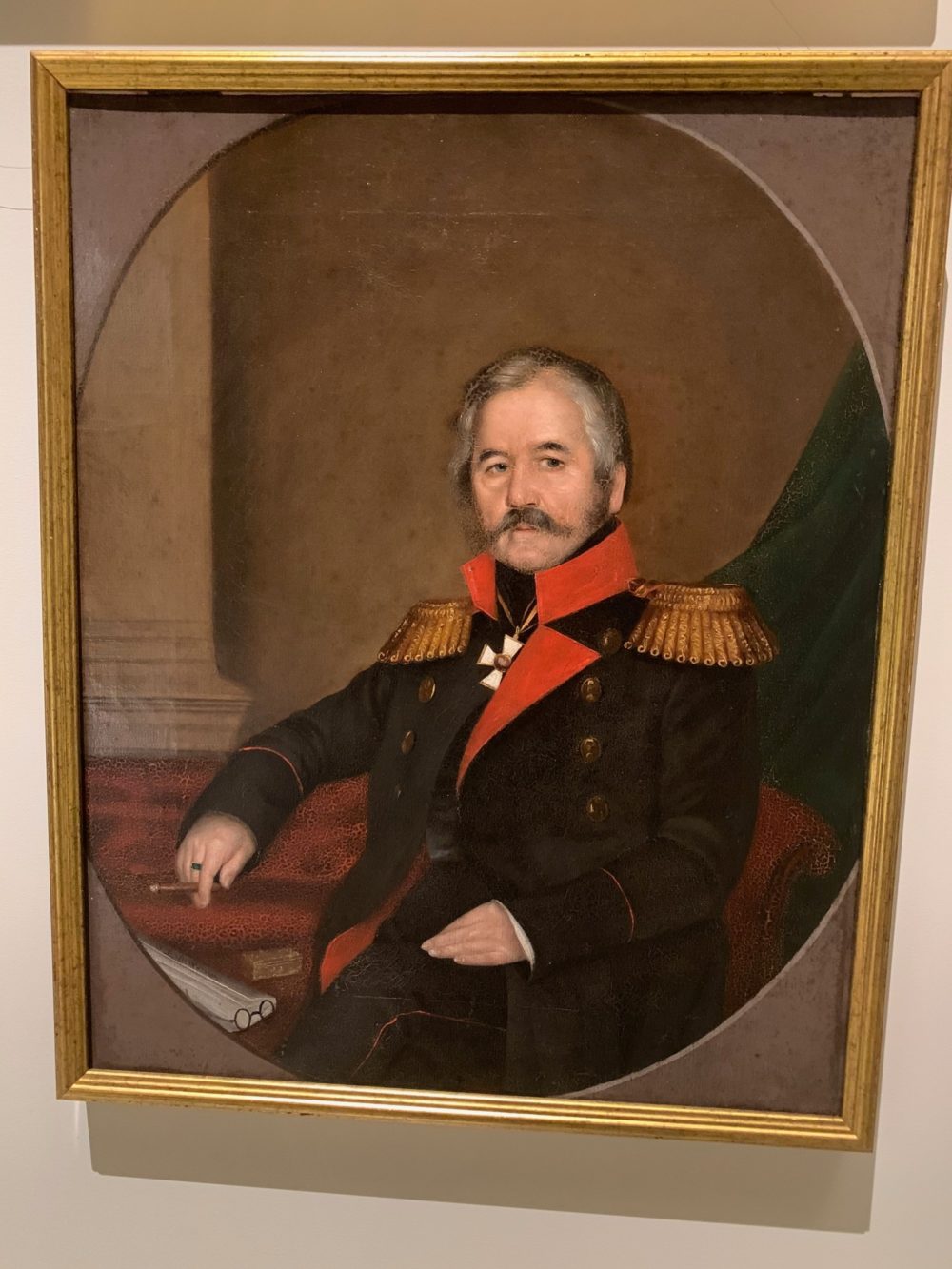
To read about the Volga Dream Cruise part click here.
To proceed to St. Petersburg / Peterhof part click here.
Original source of the article and images:
https://www.duskbeforethedawn.net/2019/11/volga-river-cruise-moscow-to-st-petersburg
Larry & Audrey Ketchersid, 2019

